Pair density functional theory by means of the correlated wave function
- 格式:pdf
- 大小:134.75 KB
- 文档页数:10
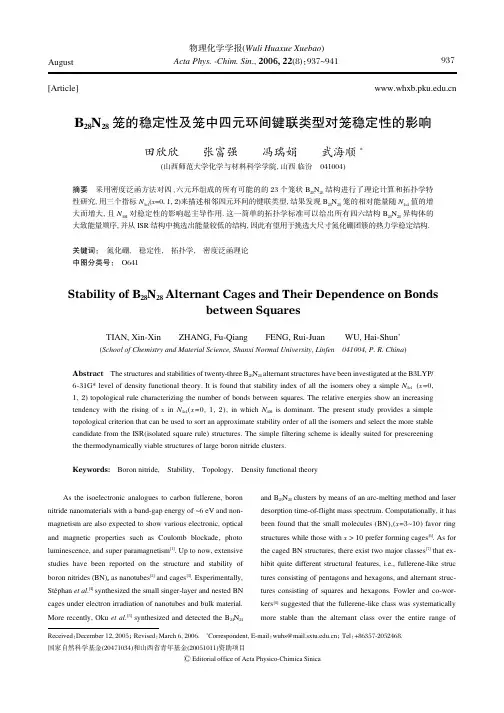
物理化学学报(Wuli Huaxue Xuebao)August Acta Phys.鄄Chim.Sin.,2006,22(8):937~941B28N28笼的稳定性及笼中四元环间键联类型对笼稳定性的影响田欣欣张富强冯瑞娟武海顺*(山西师范大学化学与材料科学学院,山西临汾041004)摘要采用密度泛函方法对四、六元环组成的所有可能的的23个笼状B28N28结构进行了理论计算和拓扑学特性研究,用三个指标N4x4(x=0,1,2)来描述相邻四元环间的键联类型,结果发现B28N28笼的相对能量随N4x4值的增大而增大,且N404对稳定性的影响起主导作用.这一简单的拓扑学标准可以给出所有四六结构B28N28异构体的大致能量顺序,并从ISR结构中挑选出能量较低的结构,因此有望用于挑选大尺寸氮化硼团簇的热力学稳定结构.关键词:氮化硼,稳定性,拓扑学,密度泛函理论中图分类号:O641Stability of B28N28Alternant Cages and Their Dependence on Bondsbetween SquaresTIAN,Xin⁃Xin ZHANG,Fu⁃Qiang FENG,Rui⁃Juan WU,Hai⁃Shun*(School of Chemistry and Material Science,Shanxi Normal University,Linfen041004,P.R.China) Abstract The structures and stabilities of twenty⁃three B28N28alternant structures have been investigated at the B3LYP/ 6⁃31G*level of density functional theory.It is found that stability index of all the isomers obey a simple N4x4(x=0, 1,2)topological rule characterizing the number of bonds between squares.The relative energies show an increasing tendency with the rising of x in N4x4(x=0,1,2),in which N404is dominant.The present study provides a simple topological criterion that can be used to sort an approximate stability order of all the isomers and select the more stable candidate from the ISR(isolated square rule)structures.The simple filtering scheme is ideally suited for prescreening the thermodynamically viable structures of large boron nitride clusters.Keywords:Boron nitride,Stability,Topology,Density functional theoryAs the isoelectronic analogues to carbon fullerene,boron nitride nanomaterials with a band⁃gap energy of~6eV and non⁃magnetism are also expected to show various electronic,optical and magnetic properties such as Coulomb blockade,photo luminescence,and super paramagnetism[1].Up to now,extensive studies have been reported on the structure and stability of boron nitrides(BN)n as nanotubes[2]and cages[3].Experimentally, Stéphan et al.[4]synthesized the small singer⁃layer and nested BN cages under electron irradiation of nanotubes and bulk material. More recently,Oku et al.[5]synthesized and detected the B24N24and B28N28clusters by means of an arc⁃melting method and laser desorption time⁃of⁃flight mass putationally,it has been found that the small molecules(BN)x(x=3~10)favor ring structures while those with x>10prefer forming cages[6].As for the caged BN structures,there exist two major classes[7]that ex⁃hibit quite different structural features,i.e.,fullerene⁃like struc tures consisting of pentagons and hexagons,and alternant struc⁃tures consisting of squares and hexagons.Fowler and co⁃wor⁃kers[8]suggested that the fullerene⁃like class was systematically more stable than the alternant class over the entire range of[Article]Received:December12,2005;Revised:March6,2006.*Correspondent,E⁃mail:wuhs@;Tel:+86357⁃2052468.国家自然科学基金(20471034)和山西省青年基金(20051011)资助项目鬁Editorial office of Acta Physico⁃Chimica Sinica937Acta Phys.鄄Chim.Sin.(Wuli Huaxue Xuebao ),2006Vol.22molecule size.Conversely,other theoretical studies conclude that alternant class would be preferred [2d,7],and these findings agreed with the more recent study of Strout [9]on B 13N 13,B 14N 14,and B 16N 16.Interestingly,our previous studies showed that the medi ⁃umsized structures [10]comprising octagons also exhibited com ⁃parable stability.However,the traditional square ⁃hexagon systems were still more stable for the large cages [11].By now we know that the stability of carbon fullerenes obeys the isolated pentagon rule(IPR)[12]and the stability of alternant boron nitrides is dominated by the isolated square rule(ISR)[13].Besides,a theoretical study of the even subset [14]of isomers up to 70atoms has verified that isolated ⁃pentagon ⁃pair(IPP)B x N x +4cages are especially stable.Furthermore,it is noteworthy that the number of possible isomers of (BN)x is an increasing function of x ,and systematic calculations performed on all of the isomers are difficult and time ⁃consuming.The filtering principles must therefore be used.The well ⁃known ISR has helped to filter out a large number of less stable isomers,however,the calculations are still expensive for the large ⁃sized structure.For the BN alternant class,does it exist any other useful filtering principles for the large ⁃sized isomers?In this article,a study of density functional theory at B3LYP/6⁃31G *level on the structures and energies of all the possible isomers of the B 28N 28is presented.It is found that the most stable isomer always has all the least number of N 4x 4(x =0,1,2)which topologically characterize the bonds between squares.And with increased number of the N 4x 4,the relative energiesinr ease consistently.The result provides useful information to experimentalists on the formation of other BN clusters.1Computational detailsAll structures of the B 28N 28isomers were optimized at the B3LYP/6⁃31G *level of density functional theory,and the corre ⁃spond ing vibrational frequency calculations at the same level were used to characterize the optimized structure to be energy minima without imaginary frequencies.Single ⁃point energies at B3LYP/6⁃311G *level of are used for discussion.The vertical ionization potentials are calculated to aid experimental study.All neutral cages were treated as closed ⁃shell singlet configura ⁃tions by using the Gaussian 03program [15].2Results and discussion2.1StructuresAll the isomers of B 28N 28were generated based on the fullerene spiral algorithms [16],and the total number was 23.Each isomer has 84B —N bonds without direct B —B and N —N conn ections.Topologically,these neutral cages can be viewed as polyhedra containing squares (f 4)and hexagons (f 6),and all of them have 6f 4and 24f 6.For simplicity,only the more stable 10optimized structures are shown in Fig.1.In order to get the location of f 4in an easy way,a N 4x 4(x =0,1,2)nomenclature is introduced to characterize bonds between f 4,in which N 404is the number of shared square B —N bonds among fused f 4,N 414is the number of B —N bonds that connectedFig.1B3LYP/6鄄31G *optimized B 28N 28isomers (1~10)vNo.8WU,Hai ⁃Shun et al .:Stability of B 28N 28Alternant Cages and Their Dependence on Bonds between Squarestwo isolated f 4,and N 424is the number of B —N —B and N —B —N linker that bridged two isolated f 4(Fig.2).The nomenclature can characterize different isomers very well.For example,isomer 1in T symmetry is an octahedron ⁃liked structure with all the f 4and f 6arranged in the most sym ⁃metric way.There are no fused f 4(N 404=0)in the structure and the numbers of B —N bonds that connected any two ⁃neighbored f 4are all 3(N 414=0,N 424=0).Isomers 3and 4are both tube ⁃liked with all the f 4dispersed averagely in the two caps.In each cap,3f 4are separated by 3fused f 6(N 404=0,N 414=0),all the 3f 4in each cap are bridged by B —N —B and N —B —N (N 424=12).Isomer 10is an oblate structure with C s symmetry,in which 2fused f 4(N 404=1)locate at one side of the cage,2B —N bridged f 4(N 414=1)locate at another side,and the left 2f 4are well isolated (N 424=0).The nomenclature for other structures is given in Table 1.2.2StabilityThe B3LYP/6⁃311G*single ⁃point energies of all structuresand their relative energies are summarized in Table 1.The vertical ionization energies (VIP)are also listed to aid experimental study.Isomer 1in T symmetry with N 404=0is the most stable B 28N 28not only in this study but also in literature [11a].The least stable isomer 23with N 404=6is higher in energy than isomer 1by 3368.67kJ ·mol -1.It can be seen clearly that the most stable structure has the minimal value of N 404while the least stable isomer has the ma ⁃ximum N 404.Additionally,considering all isomers with N 404=0,almost all of them have lower energies than those isomers with N 404逸1.The result is satisfied with the simple rule of thumb ISR [13],namely,the most stable isomer at any given N is one thatminimizes the number of square adjacencies.Examination of the full set of optimized geometries shows that the relative energies of the B 28N 28isomers increase steadily and considerably with rising of N 404.For example,among those structures with N 404=1,isomer 8is the most stable one that is Table 1B3LYP/6⁃311G *single ⁃point energies E T ,relative energies E rel ,ZPE,vertical ionization energy(E VIP ),energy gapsE g and the topological nomenclature (N 4x 4)number of B 28N 28B 28N 28Sym.E T (a.u.)E rel /(kJ ·mol -1)ZPE (kJ ·mol -1)E VIP /(kJ ·mol -1)E g /eV N 404N 414N 4241T -2232.128450.00820.3237.15 6.840002C 1-2232.08464115.02819.2737.24 6.540043C 3v -2232.06334170.95818.1436.61 5.5100124C 3v -2232.06124176.46817.8536.61 5.5100125C 1-2232.04317223.90817.5536.65 6.160146C 1-2232.03620242.20816.7636.48 6.070247C 2-2232.02092282.32816.4237.20 6.540088C 1-2232.02358275.34813.7937.11 5.771049C 1-2232.00740317.82816.1336.94 5.8511010C S -2231.97233409.89815.5036.78 5.9011011C 1-2231.97109413.15814.1636.40 5.8611212C 3-2231.95583453.21814.3736.74 5.8003013C 1-2231.94816473.35813.4536.57 5.7511214C 1-2231.92389537.07812.2036.69 5.6920015C 1-2231.91552559.05812.0336.40 5.4720016C 1-2231.90262592.92811.1536.44 5.4420017C 1-2231.90101597.14811.0336.69 5.4320018C 1-2231.84597741.65809.7336.19 5.8420419C i -2231.83400773.08808.8136.11 5.8120420C 3-2231.83376773.71805.2136.74 5.8330021C 1-2231.74823998.27808.6835.61 4.9422222S 4-2231.303192166.72786.1335.02 5.5240023C 3v-2230.845393368.67766.3835.312.616Fig.2Structure motifs of the nomenclature N 4x 4(x =0,1,2)939Acta Phys.鄄Chim.Sin.(Wuli Huaxue Xuebao ),2006Vol.22275.34kJ ·mol -1higher than isomer 1;while isomer 14,the most stable structure of those with N 404=2,is 537.07kJ ·mol -1higher than isomer 1and 261.73kJ ·mol -1higher than isomer 8.The similar behavior is also found in other isomers.It is also not claimed that all isomers with less N 404value will have lower ener ⁃gies than all isomers with high N 404value.As the energy range spanned when the number of isomers grow,some overlaps occur.However,most of them obey this rule and the most stable isomers can be surely included and selected.Thus,we can get a few likely stable isomers based on the N 404number of all isomers of a given size alternant BN cluster.Additionally,we studied the other two merits N 414and N 424in detail.For all the isomers with [a ,b ,c ](a ,b ,c in [a ,b ,c ]denotes N 404,N 414,N 424respectively),the isomers 5[0,1,4],6[0,2,4],12[0,3,0]is higher in energy than ismer 1[0,0,0]by 223.90,242.20,and 453.21kJ ·mol -1,respectively,demonstrating an inc reasing tendency of relative energy with increasing of N 414.The similar trend is also found in other isomers sharing the same N 404number but different N 414numbers,e.g.,isomer 9with [1,1,0]is 42.48kJ ·mol -1higher than isomer 8with [1,0,4];isomer 21[2,2,2]is higher in energy than the isomer 14with [2,0,0]by 461.20kJ ·mol -1.This result can help us to reduce the likely candidates again from the sorted ISR structures,and can also give a mainly picture of all isomers ′relative stability order.Furthermore,the merit N 424can provide more detailed in ⁃formation when isomers have the same N 404and N 414values.As shown in Table 1,the first four likely isomers all have [0,0,c]nomenclature.Among of them,isomers 3and 4that sharing the same nomenclature [0,0,12]are both in C 3v symmetry and very close in energy.The observed stability order is [0,0,12](isomers3,4)<[0,0,4](isomer 2)<[0,0,0](isomer 1).The same tendency can be found in other isomers with the same N 404and N 414but different N 424,such as [1,1,2](isomer 11)>[1,1,0](isomers 9,10),[2,0,4](isomers 18,19)<[2,0,0](isomers 14⁃17).It should be noted that the isomer 7with [0,0,8]in C 2sym ⁃metry is higher in energy than the two [0,0,12]isomers 3and 4.As shown in Fig.1,isomers 3and 4are both tube ⁃liked,however,isomer 7is oblate.The 6f 4of isomers 3and 4are all dispersed in the two caps while the f 4of isomer 7are all located in the belt and make the cage very flat with large strain in the structure.These energetic differences are very similar to those of fullerenes obeying the isolated pentagons rule (IPR)[17],and the relative stability of BN cages reflects the intimate interplay be ⁃tween strains of individual rings,conjugations and curvatures of the cages.For the similar reason,isomers 5[0,1,4]and 6[0,2,4]with N 414of 1and 2are also lower in energy than isomer 7.Based on the discussion above,it can be concluded that,in general,relative energies show an increasing tendency with N 4x 4(x =0,1,2)nomenclature.And the penalty caused by N 404is larger than those caused by N 414and N 424.To make the tendency clearer and more visible,Fig.3shows the variation of relative energies with numbers of topological merit N 4x 4(x =0,1,2).From the gradient of N 4x 4(x =0,1,2)against the relative energy,it can be found that,the relative order of the three kinds of gradients is N 404>N 414>N 424,i.e.,the penalty caused by N 404,N 414,and N 424decreases gradually.Therefore,N 404is further confirmed to be dominant in affecting the relative energies of isomers.3ConclusionIn summary,the topological properties and stabilities of all 23B 28N 28alternant cages have been investigated at the B3LYP level systemically.It is found that relative energies show a ten ⁃dency to rise with N 4x 4(x =0,1,2).The most stable isomer has the least number of N 4x 4(x =0,1,2).N 404is dominant in affecting the relative energies of isomers,but the influences of the N 414and N 424are also significant.The present study suggests a simple topological criterion that can be used to select the ISR isomers and choose the more stable candidate from the sorted ISR structures.The simple filtering scheme is ideally suited for prescreening the thermodynamically viable structures of large boron nitride clus ⁃ters.It may also give us a guideline for designing and synthesis of the BN clusters.Fig.3Variation of relative energy with number of N 4x 4(x =0,1,2)nomenclatureN 4x 4940No.8WU,Hai⁃Shun et al.:Stability of B28N28Alternant Cages and Their Dependence on Bonds between SquaresReferences1Oku,T.;Kuno,M.;Kitahara,H.;Nartia,I.Int.J.Inorg.Mater., 2001,3:5972(a)Saito,Y.;Maida,M.J.Phys.Chem.A,1999,103(10):129(b)Kongsted,J.;Osted,A.;Jensen,L.;Åstrand,P.O.;Mikkelsen.K.V.J.Phys.Chem.B,2001,105:10243(c)Ma,R.;Bando,Y.;Sato,T.;Kurashima,K.Chem.Mater.,2001,13:2965(d)Wu,H.S.;Xu,X.H.;Zhang,F.Q.;Jiao,H.J.J.Phys.Chem.A,2003,107:6609(e)Xu,H.;Ma,J.;Chen,X.;Hu,Z.;Huo,K.F.;Chen,Y.J.Phys.Chem.B,2004,108:40243(a)Alexandre,S.S.;Nunes,R.W.;Chacham,H.Phys.Rev.B, 2002,66:085406(b)Oku,T.;Kuno,M.;Nartia,I.Diamond Relat.Mater.,2002,11:940(c)Oku,T.;Nishiwaki,A.;Nartia,I.Physica B,2004,351:184(d)Zope,R.R.;Baruah,T.;Pederson,M.R.;Dunlap,B.I.Chem.Phys.Lett.,2004,393:3004Stéphan,O.;Bando,Y.;Loiseau,A.;Willaime,F.;Shramchenko, N.;Tamiya,T.;Sato,T.Appl.Phys.A,1998,67:1075(a)Oku,T.;Nishiwaki,A.;Nartia,I.;Gonda,M.Chem.Phys.Lett., 2003,380:620(b)Oku,T.;Nishiwaki,A.;Nartia,I.Solid State Comm.,2004,130:1716(a)Martin,J.M.L.;El⁃Yazal,J.;Francois,J.P.;Gijbels,R.Chem.Phys.Lett.,1995,232:289(b)Martin,J.M.L.;El⁃Yazal,J.Chem.Phys.Lett.,1996,248:95(c)Strout,D.L.J.Phys.Chem.A,2001,105:261(d)Jia,J.F.;Wu,H.S.;Jiao,H.J.Acta Chim.Sin.,2003,61(5):653[贾建峰,武海顺,焦海军.化学学报(Huaxue Xuebao),2003,61(5):653]7(a)Sun,M.L.;Slanina,Z.;Lee,S.L.Chem.Phys.Lett.,1995, 233:279(b)Slanina,Z.;Sun,M.L.;Lee,S.L.Nanostruct.Mater.,1997,8:6238Rogers,K.M.;Fowler,P.W.;Seifert,G.Chem.Phys.Lett.,2000, 332:439Strout,D.L.Chem.Phys.Lett.,2004,383:9510(a)Wu,H.S.;Jiao,H.J.Chem.Phys.Lett.,2004,386:369(b)Wu,H.S.;Xu,X.H.;Jia,J.F.Acta Chim.Sin.,2004,62(1):28[武海顺,许小红,贾建峰.化学学报(Huaxue Xuebao),2004,62(1):28](c)Cui,X.Y.;Wu,H.S.Chin.J.Chem.,2005,23:11711(a)Wu,H.S.;Cui,X.Y.;Qin,X.F.;Jiao,H.J.J.Mol.Struct.(THEOCHEM),2004,714:153(b)Wu,H.S.;Cui,X.Y.;Xu,X.H.J.Mol.Struct.(THEOCHEM),2005,717:10712(a)Kroto,H.W.Nature,1987,329:529(b)Schmalz,T.G.;Seitz,W.A.;Klein,D.J.;Hite,G.E.J.Am.Chem.Soc.,1988,110:111313Fowler,P.W.;Heine,T.;Mitchell,D.;Schmidt,R.;Seifert,G.J.Chem.Soc.Faraday Trans.,1996,92(12):219714Fowler,P.W.;Rogers,K.M.;Seifert,G.;Terrones,M.;Terrones.H.Chem.Phys.Lett.,1999,299:35915Frisch,M.J.;Trucks,G.W.;Schlegel,H.B.;et al.Gaussian03, Revision A.I.Pittsburgh PA:Gaussian Inc.,200316(a)Manolopoulos,D.E.;May,J.C.;Down,S.E.Chem.Phys.Lett.,1991,181:105(b)Fowler,P.W.;Manolopoulos,D.E.An atalas of fullerenes.Oxford:Oxford University Press,199517Cioslowski,J.;Rao,N.;Moncrieff,D.J.Am.Chem.Soc.,2000, 122:8265941。
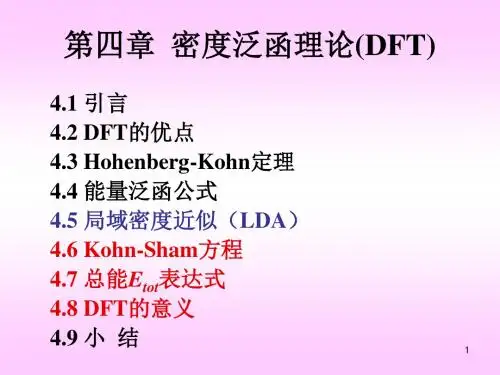
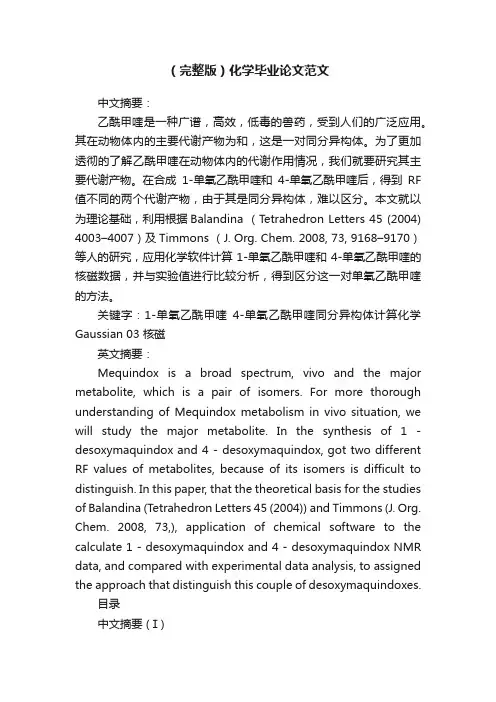
(完整版)化学毕业论文范文中文摘要:乙酰甲喹是一种广谱,高效,低毒的兽药,受到人们的广泛应用。
其在动物体内的主要代谢产物为和,这是一对同分异构体。
为了更加透彻的了解乙酰甲喹在动物体内的代谢作用情况,我们就要研究其主要代谢产物。
在合成1-单氧乙酰甲喹和4-单氧乙酰甲喹后,得到RF 值不同的两个代谢产物,由于其是同分异构体,难以区分。
本文就以为理论基础,利用根据Balandina (Tetrahedron Letters 45 (2004) 4003–4007)及Timmons (J. Org. Chem. 2008, 73, 9168–9170)等人的研究,应用化学软件计算1-单氧乙酰甲喹和4-单氧乙酰甲喹的核磁数据,并与实验值进行比较分析,得到区分这一对单氧乙酰甲喹的方法。
关键字:1-单氧乙酰甲喹4-单氧乙酰甲喹同分异构体计算化学Gaussian 03 核磁英文摘要:Mequindox is a broad spectrum, vivo and the major metabolite, which is a pair of isomers. For more thorough understanding of Mequindox metabolism in vivo situation, we will study the major metabolite. In the synthesis of 1 - desoxymaquindox and 4 - desoxymaquindox, got two different RF values of metabolites, because of its isomers is difficult to distinguish. In this paper, that the theoretical basis for the studies of Balandina (Tetrahedron Letters 45 (2004)) and Timmons (J. Org. Chem. 2008, 73,), application of chemical software to the calculate 1 - desoxymaquindox and 4 - desoxymaquindox NMR data, and compared with experimental data analysis, to assigned the approach that distinguish this couple of desoxymaquindoxes.目录中文摘要(Ⅰ)英文摘要(Ⅱ)目录……………………………………………………………Ⅲ前言 (1)1.乙酰甲喹药物用途1.1理化性质1.2抗菌作用及其机理1.3临床应用2.计算化学2.1计算化学的产生2.2计算化学的发展2.3 计算化学的现状2.4计算方法3.应用软件——Gaussian 033.1 Gaussian 03的应用3.2基组的选择4.核磁4.1NMR理论计算研究方法概述4.2化学位移概述4.3计算方法及细节5合成与计算5.1试剂与仪器5.2合成步骤5.3计算方法分析与结论参考文献 (115)致谢……………………………………………………………118 附录…………………………………………………………………前言1.乙酰甲喹药物用途1.1理化性质乙酰甲喹,化学名为3-甲基-2-乙酰基喹噁啉-N-1,4-二氧化物。
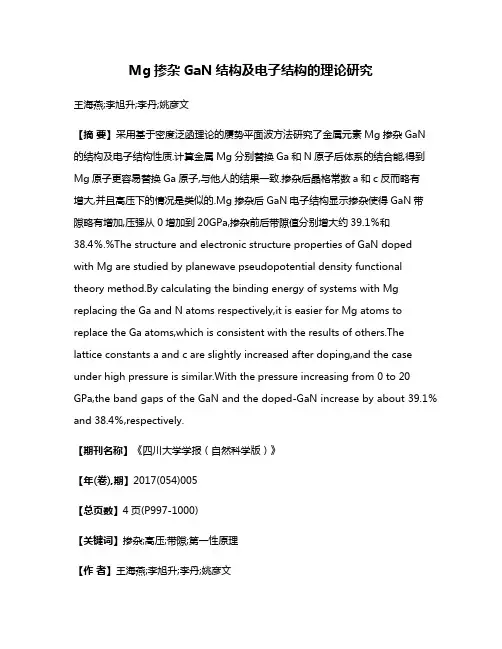
Mg掺杂GaN结构及电子结构的理论研究王海燕;李旭升;李丹;姚彦文【摘要】采用基于密度泛函理论的赝势平面波方法研究了金属元素Mg掺杂GaN 的结构及电子结构性质.计算金属Mg分别替换Ga和N原子后体系的结合能,得到Mg原子更容易替换Ga原子,与他人的结果一致.掺杂后晶格常数a和c反而略有增大,并且高压下的情况是类似的.Mg掺杂后GaN电子结构显示掺杂使得GaN带隙略有增加,压强从0增加到20GPa,掺杂前后带隙值分别增大约39.1%和38.4%.%The structure and electronic structure properties of GaN doped with Mg are studied by planewave pseudopotential density functional theory method.By calculating the binding energy of systems with Mg replacing the Ga and N atoms respectively,it is easier for Mg atoms to replace the Ga atoms,which is consistent with the results of others.The lattice constants a and c are slightly increased after doping,and the case under high pressure is similar.With the pressure increasing from 0 to 20 GPa,the band gaps of the GaN and the doped-GaN increase by about 39.1%and 38.4%,respectively.【期刊名称】《四川大学学报(自然科学版)》【年(卷),期】2017(054)005【总页数】4页(P997-1000)【关键词】掺杂;高压;带隙;第一性原理【作者】王海燕;李旭升;李丹;姚彦文【作者单位】河南理工大学材料科学与工程学院,焦作454003;河南理工大学材料科学与工程学院,焦作454003;攀枝花学院材料工程学院,攀枝花617000;河南理工大学材料科学与工程学院,焦作454003【正文语种】中文【中图分类】O521+.2以氮化镓(GaN)为代表的宽禁带材料,是继Si和GaAs之后的第三代半导体,是研制微电子器件、光电子器件的新型半导体材料. 它具有宽的直接带隙、强的原子键、化学稳定性好(几乎不被任何酸腐蚀)、高热导率、难压缩和强的抗辐照能力等特性,被认为是最有前途的宽带隙半导体材料[1].掺杂被认为是改善半导体性能的一种有效途径[2, 3]. 理论计算发现金属元素Mn,Cr或V掺杂有可能使得GaN的居里温度(TC)高于室温[4-7],这一预言引起了人们的广泛关注.对理想半导体掺杂可以使其性能得到更好的应用,比如金属Al掺杂到GaN晶体中可使得光学带隙在3.42~6.20 eV (300 K时)范围变化,使得其发射波长覆盖整个可见光区及部分紫外线区;金属Mg掺杂到GaN晶体中可得到p 型GaN,p型GaN的实现解决了制造GaN发光器件的一个难题. 实际上,金属元素掺杂GaN,不论在实验上还是在理论上都有大量的研究. 邢等人[8]利用广义梯度近似(GGA)研究了Mn掺杂GaN的电子结构和光学性能,结果表明,Mn掺杂GaN使得Mn3d与N2p轨道杂化,产生自旋极化杂质带,材料表现为半金属性,非常适于自旋注入,说明该种材料是实现自旋电子器件的理想材料. 孙等人[9]采用同样的方法研究了Zn掺杂GaN电子结构及光学性能.实验上发现通过Mg掺杂可以提高样品中空穴的迁移率. 然而至今如何获得高掺杂浓度和高质量的p型GaN,搞清楚Mg掺杂对GaN性质影响的微观机制,仍是热点问题. 微观上Mg掺杂的占位问题,以及掺杂对GaN结构及电子结构性质的影响等相关研究报道较少,这些问题有助于我们更好地分析实验结果. 因此,本文利用基于密度泛函理论的第一性原理方法,对Mg掺杂纤锌矿结构的GaN进行了研究,详细分析了Mg掺杂占位,掺杂体系的结构性质,以及能带结构. 对Mg掺杂后影响GaN的结构和电学性质进行了理论解释,为实验提供了理论依据.文中计算采用基于密度泛函理论的赝势平面波方法,平面波截断能为350 eV,交换关联能采用广义梯度近似(GGA),交换关联势取 Perdew Burke Ernzerhof (PBE)[10]形式. 采用超软赝势[11], Ga和N的价电子分别取为3d104s24p1和2s22p3,其他轨道电子视为芯电子. 布里渊区采用9×9×6 Monkhorst-Pack[12] 形式的特殊K点,自洽计算时总能量收敛设为1.0×10-6 eV/atom.3.1 计算模型通常来讲,晶格取代和间隙填充是掺杂原子在掺杂体系中的两种位置. 在此研究过程中,由于掺杂原子Mg半径较大,较难形成间隙填充,所以通常是以晶格取代形式为主的掺杂. 为了判断掺杂原子Mg是优先占据GaN体系中Ga原子还是N原子的位置,我们分别计算两种掺杂体系的结合能,结合能的差值(Eb 可以反映掺杂原子的占位情况. (Eb如下式:(Eb=Eb(GaN→Ga8N7Mg)- Eb(GaN→Ga7N8Mg)=[Etot(G a8N7Mg)-Etot(Ga8N8)-[Etot(Ga7N8Mg)-Etot(Ga8N8)+Etot(Ga)-Etot(N)]=Etot(Ga8N7Mg)-Etot(Ga7N8Mg)-Etot(Ga)+Etot(N)下标b和tot分别表示体系的结合能和总能,Etot(Ga),Etot(N)和Etot(Mg)分别表示独立Ga,N原子和掺杂Mg原子的能量. 我们分别计算Ga和N原子被掺杂原子Mg取代的体系总能量以及独立原子的能量,从而可以得到两种掺杂体系的结合能差值约为17.37 eV,也就是说掺杂原子替换Ga原子时的结合能更低,即掺杂原子更容易占据Ga原子的位置,这与理论计算和实验结果一致[13, 14]. 因此,选择用Mg原子替换Ga原子的掺杂模型进行计算.掺杂体系为(2×2×1)超晶胞,对应的掺杂浓度为6.25%.3.2 掺杂体系的结构性质为了研究掺杂对GaN结构性质的影响,计算了不同压力下掺杂前后体系的晶格常数a和c,如图1(a)和图1(b)所示. 出现这一反常现象的主要原因是形成Mg-N 键键长(0.206 nm)和远离Mg的Ga-N键键长(0.198 nm)都比Ga-N键的平均值(0.196 nm)长,高压下的情况是类似的. 此外,Mg2+替代Ga3+造成了晶格畸变,从而导致残余应力的产生,使得掺杂体系的能量升高,体积增大,所以它的晶胞参数稍微有些增大.3.3 掺杂体系的微观电子结构图2给出了零压下金属元素Mg掺杂前后GaN晶体的能带结构图. 从图2(a)中可以看出,掺杂前GaN是直接带隙半导体,导带底与价带顶都位于布里渊区的G点上,禁带宽度为1.61 eV,均小于实验值3.39 eV,与邢海英[15] 和Pugh[16]等人的计算结果一致. 由于在计算中采用的密度泛函理论是基态理论,而能隙属于激发态,因此,带隙结果偏低是采用该理论计算时普遍存在的现象.图2(b)是零压下金属Mg掺杂浓度为6.25%的GaN体系的能带结构图. 与图2(a)中掺杂前GaN的能带结构图相比,掺杂金属元素Mg后,晶体的价带、导带的数量明显增多、变密,导带底和价带顶都位于G点,仍然为直接带隙半导体. 带隙宽度为1.742 eV,掺杂后带隙变大.图3给出了不同压力下掺杂前后GaN体系的带隙值. 由图可以看出,Mg掺杂GaN后使得带隙变大,并且带隙均随着压强的增大而增大,压强从0增加到20 GPa,掺杂前后带隙值分别增大约39.1%和38.4%. 说明压强使得GaN晶体的绝缘性增强. 带隙随着压强的增大而增大,主要由于晶体材料中原子间距离减小,电子云重叠程度增大,电荷之间的相互作用增强,导致晶体材料中的原子之间由离子键向共价键转变,带隙变大,绝缘性增强[17].采用基于密度泛函理论的赝势平面波方法研究了金属元素Mg掺杂对GaN性质的影响. 晶格取代和间隙填充是掺杂原子在掺杂体系中的两种位置,由于掺杂原子Mg半径较大,较难形成间隙填充,所以通常是以晶格取代的形式掺杂. 通过计算金属Mg掺杂分别替换Ga和N原子后体系结合能的变化,得到Mg原子更容易替换Ga原子,与他人的结果一致.计算了不同压力下掺杂前后体系的晶格常数a和c,掺杂后晶格常数a和c略有增大,并且高压下的情况是类似的,这主要是由掺杂后形成Mg-N键键长比掺杂前原子之间的平均键长长导致的. 另外,掺杂造成了晶格畸变,使得掺杂体系的能量升高,体积增大. 通过对Mg掺杂前后GaN电子结构的计算发现,掺杂使得GaN 带隙略有增加,且带隙均随着压强的增大而增大,压强从0增加到20 GPa,掺杂前后带隙值分别增大约39.1%和38.4%.【相关文献】[1] 谢长坤, 徐法强, 邓锐, 等. GaN(0001)表面的电子结构研究[J]. 物理学报, 2002, 51: 2606.[2] 周殿凤, 陈红霞, 庄国策. C掺杂ZnS纳米线电子性质和磁性质[J]. 四川大学学报: 自然科学版, 2016, 53: 1307.[3] 张春红, 张忠政, 邓永荣, 等. 稀土(Sc、Y、La)掺杂CdS光电性质的第一性原理研究[J].四川大学学报: 自然科学版, 2017, 54: 108.[4] Dietl T, Ohno H, Matsukura F, et al. Zener model description of ferro-magnetism in zinc-blende magdnetic semiconductors [J]. Science, 2000, 287: 1019.[5] Dietl T, Ohno H, Matsukura F. Hole-mediated ferromagnetism in tetrahedrally coordinated semiconductors [J]. Phys Rev B, 2001, 63: 195205.[6] Crooker S A, Furis M, Lou X, et al. Imaging spin transport in lateralferromagnet/semiconductor structures [J]. Science, 2005, 309: 2191.[7] Van Schilfgaarde M, Mryasov O N. Anomalous exchange interactions in Ⅲ-Ⅴ dilute magnetic semiconductors [J]. Phys Rev B, 2001, 63: 233205.[8] 邢海英, 范广涵, 赵德刚, 等. Mn 掺杂GaN 电子结构和光学性质研究[J]. 物理学报, 2008, 57:6513.[9] 孙美玉, 曾江斌, 张伟, 等. Zn掺杂GaN电子结构及光学性质的第一性原理研究[J]. 鲁东大学学报, 2012, 28: 322.[10] Perdew J P, Burke K, Ernzerhof M. Generalized gradient approximation made simple [J]. Phys Rev Lett, 1996, 77: 3865.[11] Vanderbilt D. Soft self-consistent pseudopotentials in a generalized eigenvalue formalism [J]. Phys Rev B, 1990, 41: 7892.[12] Monkhorst H J, Pack J D. Special points for Brillouin-zone integrations [J]. Phys Rev B, 1976, 13: 5188.[13] Larson P, Lambrecht W, Chantis A, et al.Electronic structure of rare-earth nitrides using the LSDA+ U approach: importance of allowing 4f orbitals to break the cubic crystal symmetry [J].Phys Rev B, 2007, 75: 045114.[14] 李倩倩, 郝秋艳, 李英, 等.稀土元素(Ce,Pr)掺杂GaN的电子结构和光学性质的理论研究[J].物理学报, 2013, 62: 017103.[15] Xing H Y, Fan G H, Zhang Y, et al.First principle study of Mg, Si and Mn co-doped GaN [J].Acta Phys Sin, 2009, 58: 450.[16] Push S K, Dugdale D J, Brand S, et al.Electronic structure calculations on nitride semiconductors [J]. Semicond Sci Technol, 1999, 14: 23.[17] Ramzan M,Hussain T,Ahuja R. High pressure phase determination and electronic properties of lithiumamidoborane [J]. Appl Phys Lett, 2012, 101: 111902.。
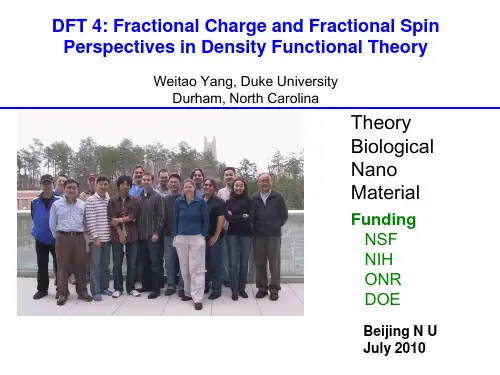
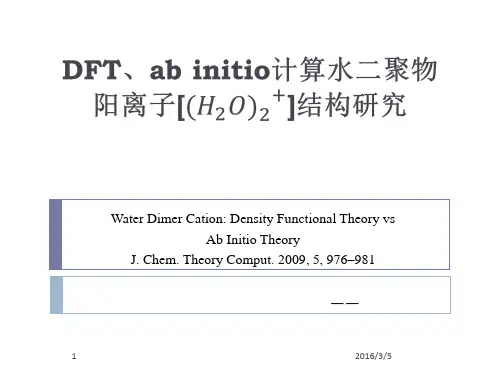
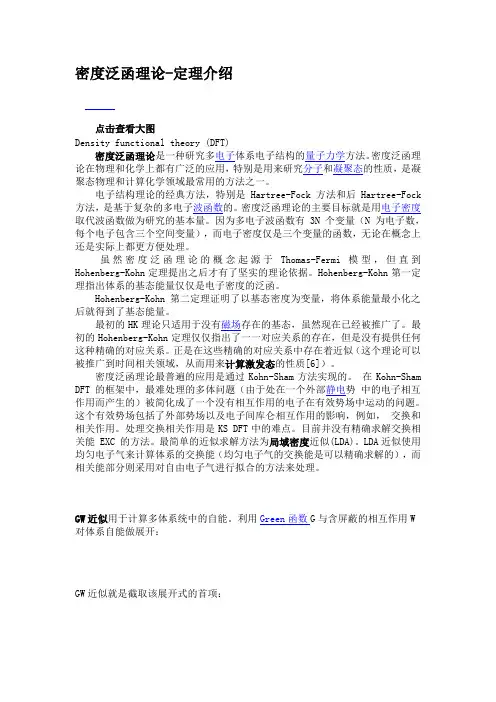
密度泛函理论-定理介绍点击查看大图Density functional theory (DFT)密度泛函理论是一种研究多电子体系电子结构的量子力学方法。
密度泛函理论在物理和化学上都有广泛的应用,特别是用来研究分子和凝聚态的性质,是凝聚态物理和计算化学领域最常用的方法之一。
电子结构理论的经典方法,特别是Hartree-Fock方法和后Hartree-Fock 方法,是基于复杂的多电子波函数的。
密度泛函理论的主要目标就是用电子密度取代波函数做为研究的基本量。
因为多电子波函数有 3N 个变量(N 为电子数,每个电子包含三个空间变量),而电子密度仅是三个变量的函数,无论在概念上还是实际上都更方便处理。
虽然密度泛函理论的概念起源于Thomas-Fermi模型,但直到Hohenberg-Kohn定理提出之后才有了坚实的理论依据。
Hohenberg-Kohn第一定理指出体系的基态能量仅仅是电子密度的泛函。
Hohenberg-Kohn第二定理证明了以基态密度为变量,将体系能量最小化之后就得到了基态能量。
最初的HK理论只适用于没有磁场存在的基态,虽然现在已经被推广了。
最初的Hohenberg-Kohn定理仅仅指出了一一对应关系的存在,但是没有提供任何这种精确的对应关系。
正是在这些精确的对应关系中存在着近似(这个理论可以被推广到时间相关领域,从而用来计算激发态的性质[6])。
密度泛函理论最普遍的应用是通过Kohn-Sham方法实现的。
在Kohn-Sham DFT的框架中,最难处理的多体问题(由于处在一个外部静电势中的电子相互作用而产生的)被简化成了一个没有相互作用的电子在有效势场中运动的问题。
这个有效势场包括了外部势场以及电子间库仑相互作用的影响,例如,交换和相关作用。
处理交换相关作用是KS DFT中的难点。
目前并没有精确求解交换相关能 EXC 的方法。
最简单的近似求解方法为局域密度近似(LDA)。
LDA近似使用均匀电子气来计算体系的交换能(均匀电子气的交换能是可以精确求解的),而相关能部分则采用对自由电子气进行拟合的方法来处理。
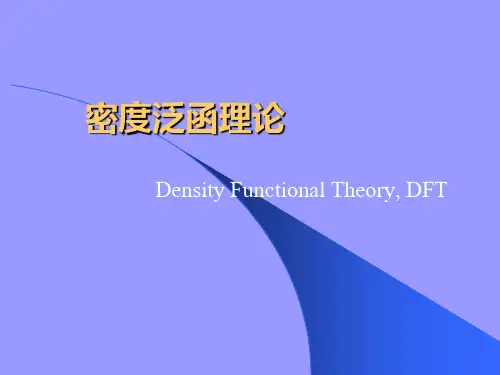
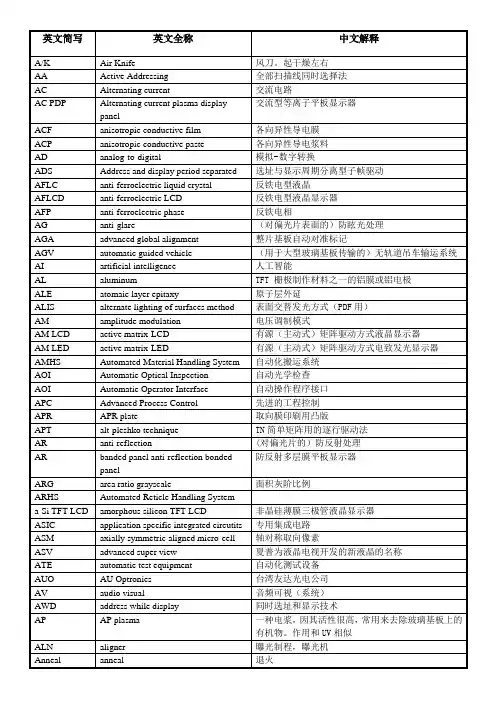
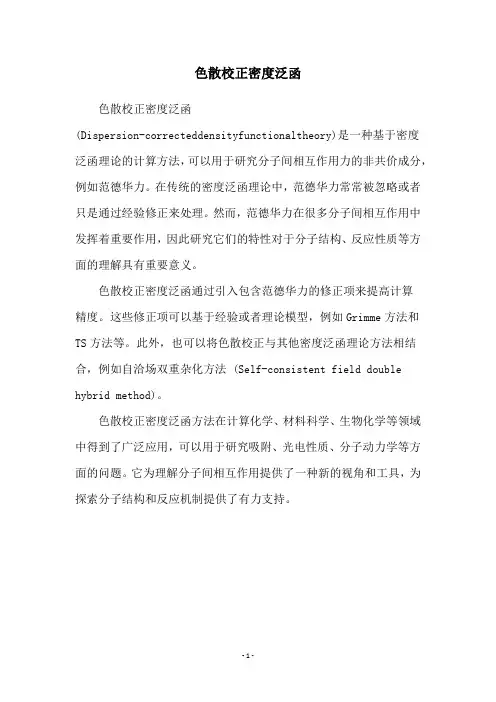
色散校正密度泛函
色散校正密度泛函
(Dispersion-correcteddensityfunctionaltheory)是一种基于密度
泛函理论的计算方法,可以用于研究分子间相互作用力的非共价成分,例如范德华力。
在传统的密度泛函理论中,范德华力常常被忽略或者只是通过经验修正来处理。
然而,范德华力在很多分子间相互作用中发挥着重要作用,因此研究它们的特性对于分子结构、反应性质等方面的理解具有重要意义。
色散校正密度泛函通过引入包含范德华力的修正项来提高计算
精度。
这些修正项可以基于经验或者理论模型,例如Grimme方法和TS方法等。
此外,也可以将色散校正与其他密度泛函理论方法相结合,例如自洽场双重杂化方法 (Self-consistent field double hybrid method)。
色散校正密度泛函方法在计算化学、材料科学、生物化学等领域中得到了广泛应用,可以用于研究吸附、光电性质、分子动力学等方面的问题。
它为理解分子间相互作用提供了一种新的视角和工具,为探索分子结构和反应机制提供了有力支持。
- 1 -。
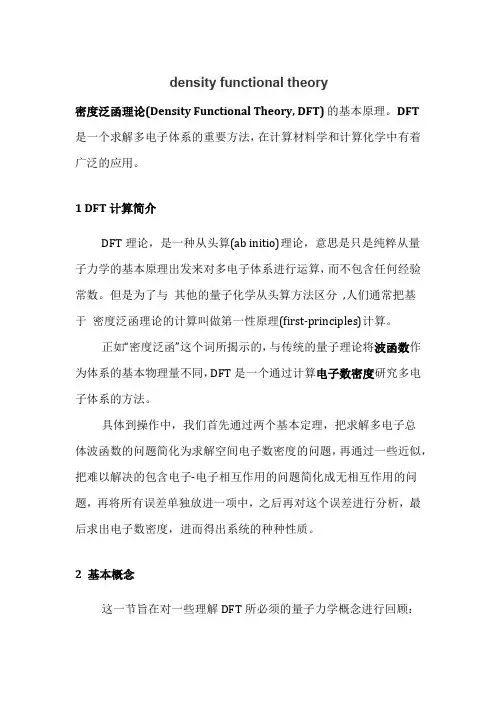
density functional theory密度泛函理论(Density Functional Theory, DFT)的基本原理。
DFT是一个求解多电子体系的重要方法,在计算材料学和计算化学中有着广泛的应用。
1 DFT计算简介DFT理论,是一种从头算(ab initio)理论,意思是只是纯粹从量子力学的基本原理出发来对多电子体系进行运算,而不包含任何经验常数。
但是为了与其他的量子化学从头算方法区分,人们通常把基于密度泛函理论的计算叫做第一性原理(first-principles)计算。
正如“密度泛函”这个词所揭示的,与传统的量子理论将波函数作为体系的基本物理量不同,DFT是一个通过计算电子数密度研究多电子体系的方法。
具体到操作中,我们首先通过两个基本定理,把求解多电子总体波函数的问题简化为求解空间电子数密度的问题,再通过一些近似,把难以解决的包含电子-电子相互作用的问题简化成无相互作用的问题,再将所有误差单独放进一项中,之后再对这个误差进行分析,最后求出电子数密度,进而得出系统的种种性质。
2 基本概念这一节旨在对一些理解DFT所必须的量子力学概念进行回顾:•波函数:在量子力学中,求解薛定谔方程波函数完备地描述了这个系统的状态,可以类比为经典力学中求得的牛顿方程的解。
•算符:对变量施加的数学运算(比如乘上一个数,对它求导等等)。
量子力学中,可观测量(比如位置、动量)由一类特殊的算符,即厄米算符表示。
•基态:一个系统最稳定的状态,或者说能量最低的状态。
3 从量子力学到凝聚态物理理论化学实际上就是物理。
但是,必须强调的是,这种解释只是原则上的。
我们已经讨论过了解下棋规则与擅长下棋之间的差别。
也就是说,我们可能知道有关的规则,但是下得不很好。
我们知道,精确地预言某个化学反应中会出现什么情况是十分困难的;然而,理论化学的最深刻部分必定会归结到量子力学。
——理查德·费曼,费曼物理学讲义,1962这一节中,我们从凝聚态物理和材料学的实际需求出发,探讨量子力学的基本原理如何应用于多原子体系的计算,进而指出引出密度泛函理论的讨论对象——电荷数密度的必要性。
dft程序计算大分子结构英文回答:DFT (Density Functional Theory) is a computational method used to calculate the electronic structure of molecules and solids. It is widely used in materials science, chemistry, and physics to study the properties and behavior of large molecular systems.In DFT, the Schrödinger equation is solved by approximating the electron density, rather than the wave function, as the fundamental variable. This makes the calculations more efficient and allows for the study of larger systems that would be computationally infeasible using other methods.To perform a DFT calculation for a large molecule, several steps are involved. First, the molecular structure is optimized by finding the arrangement of atoms that minimizes the total energy. This is done by iterativelyadjusting the positions of the atoms until no further energy decrease can be achieved.Once the optimized structure is obtained, the next step is to calculate the electronic properties. This involves solving the Kohn-Sham equations, which are derived from the electron density and the effective potential. The solutions to these equations provide information about the energy levels, electron distribution, and other electronic properties of the molecule.There are several software packages available for performing DFT calculations, such as Gaussian, VASP, and Quantum ESPRESSO. These programs implement various numerical methods and algorithms to solve the Kohn-Sham equations and calculate the electronic properties.DFT calculations can provide valuable insights into the behavior of large molecular systems. For example, they can be used to predict the stability and reactivity of molecules, study the electronic structure of materials, and investigate the interaction between molecules and surfaces.中文回答:DFT(密度泛函理论)是一种计算方法,用于计算分子和固体的电子结构。
生态毒理学报Asian Journal of Ecotoxicology第18卷第3期2023年6月V ol.18,No.3Jun.2023㊀㊀基金项目:国家自然科学基金资助项目(22176211,21677125)㊀㊀第一作者:宋润芊(1997 ),女,硕士研究生,研究方向为环境计算化学和毒理学,E -mail:***********.cn ㊀㊀*通信作者(Corresponding author ),E -mail:***************.cnDOI:10.7524/AJE.1673-5897.20230212001宋润芊,金玲敏,苏丽静,等.细胞色素P450酶代谢N -亚硝胺类化合物的反应机理研究[J].生态毒理学报,2023,18(3):68-78Song R Q,Jin L M,Su L J,et al.Mechanisms of N -nitrosamines metabolized by cytochrome P450enzymes [J].Asian Journal of Ecotoxicology,2023,18(3):68-78(in Chinese)细胞色素P450酶代谢N -亚硝胺类化合物的反应机理研究宋润芊1,金玲敏2,苏丽静2,季力2,*1.浙江大学环境与资源学院,杭州3100582.中国矿业大学环境与测绘学院,徐州221000收稿日期:2023-02-12㊀㊀录用日期:2023-04-10摘要:细胞色素P450酶在生物体内分布广泛,在有机污染物的代谢中发挥重要作用㊂N -亚硝胺类化合物(N -nitrosamines,NAs)在P450酶的初始催化作用下,所生成的亲电化合物易于与DNA 加合,从而可能产生致畸变和致癌毒性㊂本研究对21种NAs 的α-C 上的C H 键解离能(bond dissociation energy,BDE C -H )和P450酶介导的α-羟基化反应的氢提取活化能(ΔE *)进行密度泛函理论计算模拟,探讨链状和环状NAs 的BDE C -H 和ΔE *的规律㊂计算结果表明,链状NAs 的BDE C -H 为83.8~91.6kcal ㊃mol -1(1kcal =4.1859kJ),ΔE *为8.3~15.9kcal ㊃mol -1(1kcal =4.1859kJ);环状NAs 的BDE C -H 为74.4~88.6kcal ㊃mol -1(1kcal =4.1859kJ),ΔE *为8.7~15.1kcal ㊃mol -1(1kcal =4.1859kJ)㊂建立的NAs 反应性模型经多元线性回归(MLR)拟合后表明模型的稳健性良好,链状NAs 模型的可决系数(R 2)=0.9,平均绝对误差(MAE)=0.8kcal ㊃mol -1(1kcal =4.1859kJ),环状NAs 模型的R 2=0.9,MAE =1.0kcal ㊃mol -1(1kcal =4.1859kJ)㊂同时,以甲基乙烯基亚硝胺为例,理论预测P450酶代谢的环氧化反应和羟基化反应的区域选择性,从动力学和热力学角度表明2种反应均可发生㊂本研究开发了一种计算成本小的P450酶代谢NAs 作用机制的方法,从而为NAs 环境健康风险评估提供理论基础㊂关键词:N -亚硝胺类化合物;细胞色素P450酶;代谢毒性;密度泛函理论;预测模型;区域选择性文章编号:1673-5897(2023)3-068-11㊀㊀中图分类号:X171.5㊀㊀文献标识码:AMechanisms of N -nitrosamines Metabolized by Cytochrome P450EnzymesSong Runqian 1,Jin Lingmin 2,Su Lijing 2,Ji Li 2,*1.College of Environmental and Resource Sciences,Zhejiang University,Hangzhou 310058,China2.School of Environment and Spatial Informatics,China University of Mining and Technology,Xuzhou 221000,ChinaReceived 12February 2023㊀㊀accepted 10April 2023Abstract :Cytochrome P450enzymes (CYP450)distribute widely in organisms,which play an important role in the metabolism of organic pollutants.N -nitrosamines (NAs),can produce electrophilic compounds initially cata -lyzed by CYP450,that are susceptible to attack DNA base,which may produce teratogenic and carcinogenic effects.In this study,density functional theory (DFT)computations were performed to calculate the C H bond dissociation energy (bond dissociation energy,BDE C -H )on α-C and the activation energy of hydrogen extraction (ΔE *)for CYP450-mediated α-hydroxylation reactions of 21diverse NAs.The reasonable patterns of BDE C -H and ΔE *of chain and cyclic NAs were explored.The results showed that the BDE C -H of chain NAs were within 83.8~第3期宋润芊等:细胞色素P450酶代谢N -亚硝胺类化合物的反应机理研究69㊀91.6kcal ㊃mol -1and ΔE *values were within 8.3~15.9kcal ㊃mol -1(1kcal =4.1859kJ);while the BDE C -H of cy -clic NAs were within 74.4~88.6kcal ㊃mol -1and ΔE *values were within 8.7~15.1kcal ㊃mol -1(1kcal =4.1859kJ).The built reactivity results of NAs showed that the models had the good -of -fit by multiple linear regression (MLR),with R 2=0.9and mean absolute error (MAE)=0.8kcal ㊃mol -1(1kcal =4.1859kJ)for the chain NAs model and R 2=0.9and MAE =1.0kcal ㊃mol -1(1kcal =4.1859kJ)for the ring NAs model.In the meanwhile,the theoretical predictions of the regioselectivity of the epoxidation and hydroxylation reactions of CYP450metabo -lism,using N -nitroso -N -methylvinylamine as a model substrate,showed that both reactions can occur from kinetic and thermodynamic analysis.Therefore,this study developed a method to study the mechanism of NAs by CYP450with a small computational cost,providing a theoretical basis for their environmental health risk assessment of NAs.Keywords :N -nitrosamines;cytochrome P450enzymes;metabolic toxicity;density functional theory;predictive model;regioselectivity㊀㊀N -亚硝胺类化合物(N -nitrosamines,NAs)是指结构通式为R 1(R 2)N NO 的化合物,其中R 1㊁R 2是不同的取代基团㊂NAs 存在于食品㊁烟草㊁饮用水㊁药物和化妆品中[1-2],同时在地下水㊁土壤等环境介质中也有检出[3-4]㊂自1956年N -二甲基亚硝胺(NDMA)被证明容易诱导大鼠肝脏恶性肿瘤的发生以来[5],迄今发现了200多种NAs 具有致癌活性[6],并且NAs 会在包括高等灵长动物在内的40多种动物中诱发癌症[7]㊂人体受NAs 影响会导致食道癌㊁胃癌㊁鼻咽癌㊁乳腺癌等癌症的发生[7-8]㊂细胞色素P450酶(P450酶)在环境污染物的生物转化过程中起着重要的作用,大约2/3人类酶活化致癌物的反应都与P450酶有关[9-10]㊂NAs 进入生物体后,可被P450酶代谢生成比母体化合物毒性更强的代谢产物[11]㊂其中,经过P450酶代谢后形成的羟基化产物会自发分解,形成烷基重氮离子,与DNA 发生加合反应,从而激活NAs 的致癌的潜力[12-13]㊂因此,明确P450酶代谢NAs 的反应机理对于NAs 致癌性的研究有着极其重要的作用㊂P450酶代谢的α-羟基化反应是NAs 代谢活化的关键步骤[14]㊂测定动力学同位素效应的实验结果表明,由P450酶活性中心进行的氢提取过程是α-羟基化反应的速率决定步骤[15]㊂铁(Ⅳ)-氧血红素阳离子自由基化合物Ⅰ(compound Ⅰ,Cpd Ⅰ)是被普遍认可的代谢活性物种,由P450酶在其催化循环过程中形成[16]㊂Cpd Ⅰ的[FeO]部分可以对NDMA甲基上的氢原子进行提取,羟基反弹到α-亚硝胺自由基,从而完成羟基化过程[17]㊂由于Cpd Ⅰ反应活性高㊁存在寿命短,通常很难在实验中对其进行捕捉和表征,理论计算可以作为研究P450酶代谢机理的有效手段[18]㊂已有研究者对P450酶代谢活化少量典型的NAs (例如:N -甲基-N -亚硝基甲胺㊁4-甲基亚硝氨基-1-(3-吡啶基)-1-丁酮)的反应进行了密度泛函理论(DFT)计算,分析了P450酶代谢这些NAs 的反应路径,包括羟基化反应㊁脱亚硝基反应㊁N -氧化反应[17-20]㊂Li 和Hecht [21]总结了人类频繁接触的10种NAs ,分为环状和非环状2种类型讨论了其致癌活化的反应过程㊂然而,已有的研究是仅针对某种具体化合物的反应,很难判别种类众多的NAs 的反应活性和致癌潜力㊂因此,本研究借助理论计算方法,基于活化反应机理,探究不同NAs 的代谢规律㊂反应物的键能是预测其反应性的重要指标[22]㊂特别地,氢原子提取的反应活化能与C H 键的解离能(BDE C -H )呈显著相关[23-24]㊂理论计算存在着耗时㊁对硬件设备要求高等问题,体系复杂的反应计算难度也会较大[23]㊂但是,BDE C -H 的计算相对来说体系简单,计算方便快捷㊂因此,本研究将通过BDE C -H 来预测NAs 氢提取反应的活化能,有助于快速地判断脱烷基的反应活性㊂本研究通过DFT 计算,得到BDE C -H ,并且计算了链状和环状NAs 的反应活化能㊂通过数学模型构建NAs 的α-羟基化反应活化能与BDE C -H 的相关关系,揭示NAs 代谢规律,以此对不同种类的NAs 的反应性和致癌潜力进行快速有效的评估;同时,对含有CC 键的NAs 羟基化和环氧化的区域选择性进行分析,以加深对P450酶催化不同类型NAs 反应的理解㊂1㊀计算方法(Computational methods )1.1㊀DFT 计算本研究选取六配体三自由基复合物[Fe 4+O 2-(C 20N 4H 12)-1(SH)-1](Cpd Ⅰ)作为活性位点模型,70㊀生态毒理学报第18卷NAs(结构式见表1)作为P450酶催化反应的底物,对CpdⅠ在高自旋(HS)四重态或低自旋(LS)二重态下进行考察[25]㊂几何结构采用非限制性的DFT优化,B3LYP杂化密度泛函结合LANL2DZ基组用于Fe,而6-31G**基组用于C㊁H㊁N㊁O原子(记作UB3LYP/BSⅠ,简称BSⅠ)㊂采用B3LYP的原因是它可以准确地重现P450酶催化反应的动力学同位素效应的测量值[26]和P450酶亚铁血红素的电子顺磁共振参数值[27],形成与结晶结构一致的几何形状[28],并且得到相对于基准CASSCF计算更加精准的能量值[29]㊂反应分子的振动频率进一步用于零点能(ZPE)校正,并且在298.15K和101.325kPa的条件下进行吉布斯自由能校正㊂通过振动模式分析,所有的基态的频率都为实频,过渡态只有一个虚频,振动方向沿着反应坐标方向㊂采用PCM连续化溶剂模型(介电常数ε=5.7,氯苯)模拟酶环境,评估周围蛋白质的极化效应[30]㊂通过UB3LYP-D3/BSⅠ基组进行单点能计算得到D3色散校正项,以此弥补B3LYP 方法所缺乏的对色散相互作用的考虑[31]㊂采用计算铁原子的SDD基组,计算其他原子的6-311++G**基组(记作UB3LYP/BSⅡ/BSⅠ,简称BSⅡ),在更高水平下进行单点(SP)计算以获得更加精确的能量[32]㊂本研究中反应的相对自由能是在BSⅠ水平下进行结构优化,与ZPE校正㊁B3LYP/BSⅡ单点能校正㊁PCM溶剂化校正和色散D3校正结合来估计的㊂BDEC-H与羟基化的活化能紧密相关[24],选取BDEC-H作为评估反应底物的NAs的反应性的重要参数㊂BDEC-H是指氢原子和解离掉氢原子的自由基的能量之和减去底物原始的能量,表示底物解离一个氢原子的难易程度[33]㊂在BSⅠ水平上进行焓能校正,获得NAs的BDEC-H能量㊂所有计算均由Gaussian16软件包完成[34]㊂表1㊀亚硝胺类化合物结构㊁C H键解离能(BDE C-H)和四重态CpdⅠ介导的氢提取反应活化能(ΔE*)以及分子描述符Table1㊀Structures,bond dissociation energies(BDEC-H)and activation energies(ΔE*) of hydrogen-abstraction by CpdⅠin HS state and molecular descriptors of NAs序号No.亚硝胺类化合物N-nitrosamines反应位点ReactionsitesΔE*计算值Calculatedvalues预测值PredictedvaluesBDE C-HMα/(a.u.)q C-/(a.c.u.)分子结构Structure1N-甲基-N-亚硝基甲胺(NDMA)N-nitrosodimethylamine(NDMA)-13.314.688.040.9-0.22亚硝基甲基乙基胺(NMEA)N-nitrosomethylethylamine(NMEA)1212.6NC11.1NC85.289.450.7-0.33N-亚硝基肌氨酸(NSAR)N-nitrososarcosine(NSAR)1215.9NC15.2NC89.991.654.8-0.24二乙基亚硝胺(NDEA)N-nitrosodiethylamine(NDEA)-12.711.987.661.4-0.35N-亚硝基二丙胺(NDPA)N-nitrosodi-N-propylamine(NDPA)-11.310.987.683.5-0.36N-亚硝基二乙醇胺(NDELA)N-nitrosodiethanolamine(NDELA)-15.114.387.368.3-0.17二丁基亚硝胺(NDBA)N-nitrosodibutylamine(NDBA)-8.37.884.2105.8-0.38二异丙基亚硝胺(NDIPA)N-nitrosodiisopropylamine(NDIPA)-9.710.887.282.0-0.3第3期宋润芊等:细胞色素P450酶代谢N-亚硝胺类化合物的反应机理研究71㊀续表1序号No.亚硝胺类化合物N-nitrosamines反应位点ReactionsitesΔE*计算值Calculatedvalues预测值PredictedvaluesBDE C-HMα/(a.u.)q C-/(a.c.u.)分子结构Structure9乙基异丙基亚硝胺(NEIPA)N-nitrosoethylisopropylamine(NEIPA)129.4NC9.3NC83.885.471.8-0.310N-亚硝基-N-甲基-4-氨基丁酸(NMBA)N-nitroso-N-methyl-4-aminobutanoic acid(NMBA)1210.0NC11.2NC86.587.776.7-0.3113-(N-亚硝基甲基氨基)丙腈(NMPN)3-(N-nitrosomethyl-amino)propionitrile(NMPN)1211.0NC11.6NC85.687.163.2-0.2123-(N-亚硝基甲基氨基)丙醛(NMPD)3-(N-nitrosomethyl-amino)propionaldehyde(NMPD)1210.0NC10.5NC84.386.962.2-0.313N-亚硝基吡咯烷(NPYR)N-nitrosopyrrolidine(NPYR)-13.310.985.058.0-0.214N-亚硝基甲基苯胺(NMPA)N-nitrosomethylphenyl-amine(NMPA)-14.614.188.690.4-0.2154-甲基亚硝氨基-1-(3-吡啶基)-1-丁酮(NNK)4-(methylnitrosamino)-1-(3-pyridyl)1-butanone(NNK)1215.1NC15.4NC86.787.7129.6-0.316N-亚硝基哌啶(NPIP)N-nitrosopiperidine(NPIP)-9.911.785.469.6-0.217N-亚硝基吗啉(NMOR)N-nitrosomorpholine(NMOR)-10.311.886.562.5-0.118N-亚硝基烟碱(NNN)N-nitrosonornicotine(NNN)1211.2NC10.9NC78.685.3109.3-0.219N-亚硝基新烟碱(NABS)N-nitrosoanabasine(NABS)1213.9NC13.0NC82.287.4121.0-0.220N-亚硝基阿那他滨(NATB)N-nitrosoanatabine(NATB)12NC8.7NC9.582.074.4118.6-0.221N-亚硝基去甲槟榔碱(NG)N-nitrosoguvacoline(NG)12NC8.8NC8.584.474.896.7-0.2223-(甲基亚硝胺基)丙腈(MNPN)3-(methylnitrosamino)propionitrile(MNPN)1214.2NC11.6NC85.587.062.6-0.2231-甲基-1-亚硝基脲(MNU)1-methyl-1-nitrosourea(MNU)-16.116.291.148.0-0.272㊀生态毒理学报第18卷续表1序号No.亚硝胺类化合物N -nitrosamines 反应位点Reaction sites ΔE *计算值Calculated values 预测值Predictedvalues BDE C -HM α/(a.u.)q C -/(a.c.u.)分子结构Structure24N -亚硝基-N -甲基-N -丙胺(NMNPA)N -methyl -N -propylnitrous amide (NMNPA)1213.0NC 11.1NC 86.291.262.1-0.325N -亚硝基二异丁胺(NNB)N -nitrosodiisobutylamine (NNB)-12.99.987.5104.1-0.3261-亚硝基-2,2-二甲基氮丙啶(NDZ)1-nitroso -2,2-dimethylaziridine (NDZ)-17.319.2104.259.2-0.3272-甲基-1-亚硝基氮杂吖啶(NMZ)2-methyl -1-nitrosoaziridine (NMZ)1215.1NC 16.2NC 98.7101.648.0-0.3281-亚硝基氮杂环吖啶(NSZ)1-nitrosoaziridine (NSZ)-17.518.3104.937.3-0.1294-(甲基亚硝胺)-1-(3-吡啶)-1-丁酮(NHPNM)N -(4-hydroxy -4-phenylbutyl)-N-methylnitrous amide (NHPNM)1213.4NC15.2NC86.187.6130.7-0.2注:BDE C -H 为解离键能,kcal ㊃mol -1(1kcal =4.1859kJ);M α为平均分子极化率;q C -为分子中碳原子的最负静电荷;ΔE *为氢提取活化能垒,kcal ㊃mol -1(1kcal =4.1859kJ);-表示该化合物无反应位点区分;NC 表示未计算该反应位点的ΔE *㊂Note:BDE C -H is bond dissociation energies of the C H bond,kcal ㊃mol -1(1kcal =4.1859kJ);M αis the average molecular polarizability;q C -is the most negative electrostatic charge of the carbon atom in the molecule;ΔE *is the activation energies of hydrogen -abstraction,kcal ㊃mol -1(1kcal =4.1859kJ);-indicates that the reaction sites of the compound are not different;NC indicates that ΔE *was not calculated.1.2㊀模型构建为了考察BDE C -H 与羟基化的活化能紧密相关性,使用模型预测相应的活化能㊂借助羟基化的活化能作为终点值,BDE C -H 以及NAs 的电荷等量子化学描述符作为变量,使用Weka 3.0进行多元线性回归(MLR)模拟[35]获得模型的拟合可决系数(R 2)和平均绝对误差(MAE),并且对8种相似结构的NAs [36-40](化合物22~化合物25为链状:MNPN ㊁MNU ㊁NMNPA ㊁NNB ;化合物26~化合物29为环状:NDZ ㊁NMZ ㊁NSZ ㊁NHPNM)进行外部验证㊂对模型进行内部去一法交叉验证以考察模型的稳健性,得到交叉验证的预测相关系数(Q 2CV )和均方根误差(RMSE CV )㊂其中,拟合优度评价系数(R 2和MAE)的计算公式如下,其余公式参考文献[41]:R 2=1-ðni =1(y i -y i )2ðni =1(y i -y )2(1)MAE =1n ðni =1yi -y i2()式中:y i 为模型回归拟合值;y i 为实验值;y为实验值的平均值;y i 为预测值;n 为数据个数㊂2㊀结果(Results )2.1㊀DFT 计算结果根据有无环状结构,将21种NAs 分为链状(化合物1~化合物12)和环状(化合物13~化合物21)2种类别㊂NMEA (化合物2)㊁NSAR (化合物3)㊁NDEA (化合物4)㊁NEIPA (化合物9)㊁NMBA (化合物10)㊁NMPN (化合物11)㊁NMPD (化合物12)㊁NMPA (化合物14)㊁NNK (化合物15)㊁NNN (化合物18)㊁NABS (化合物19)㊁NATB (化合物20)㊁NG (化合物21)的两侧取代基不同,有2个α-C ,存在2个不同的反应位点㊂DFT 计算21种NAs 的所有α-C 的BDE C -H ,BDE C -H 在74.4~91.6kcal ㊃mol -1(表1)范围内,链状NAs 的BDE C -H 为83.8~91.6kcal ㊃mol -1,环状NAs 的BDE C -H 为74.4~88.6kcal ㊃mol -1(1kcal =4.1859kJ)㊂其中,BDE C -H 最大的是NSAR (化合物3),其反应位点2(91.6kcal ㊃mol -1,1kcal =第3期宋润芊等:细胞色素P450酶代谢N -亚硝胺类化合物的反应机理研究73㊀4.1859kJ),NSAR 为链状化合物,存在与碳相连的羧基;最小的是NATB (化合物20),其反应位点2(74.4kcal ㊃mol -1,1kcal =4.1859kJ),NATB 为环状化合物,存在环内双键㊂根据BDE C -H 选取C H 键断裂的α-C 所在的反应位置,BDE C -H 越小代表C H 键的断裂所需要的能量越低,断键越容易[42]㊂进一步对BDE C -H 较小的反应位点上Cpd Ⅰ在四重态下氢提取步骤的活化能进行计算㊂在进行零点能校正㊁B3LYP/BS Ⅱ单点能校正㊁PCM 溶剂化(ε=5.7,氯苯)校正和色散D3校正后,得到Cpd Ⅰ在四重态下进行氢提取步骤的活化能结果(表1)㊂链状化合物活化能ΔE *的范围为8.3~15.9kcal ㊃mol -1,环状化合物活化能ΔE *的范围为8.7~15.1kcal ㊃mol -1(1kcal =4.1859kJ)㊂其中,ΔE *最大的是链状化合物NSAR(化合物3),其活化能为15.9kcal ㊃mol -1;最小的是链状化合物NDBA(化合物7),活化能为8.3kcal ㊃mol -1(1kcal=4.1859kJ),其取代基为2个正丁基㊂2.2㊀MLR 模型的建立为了有效预测环境中不同类型NAs 的α-羟基化反应性,本研究建立了21种NAs 在Cpd Ⅰ氢提取过程的活化能与BDE C -H 相关的模型并验证模型的稳健性㊂21种NAs 的氢提取活化能垒ΔE *作为终点,借助Weka 软件筛选了化合物的BDE C -H ㊁2种电荷描述符(分子中碳原子最正静电荷q C +和碳原子最负静电荷q C -)和部分量子化学描述符(例如:分子平均极化率M α)㊂多元线性回归构建的模型2.1如下:ΔE *=0.3ˑBDEC -H +9.7ˑq C --11.4(3)模型2.1的R 2为0.6,MAE 为1.5kcal ㊃mol -1(1kcal =4.1859kJ)㊂由于R 2较小,根据21种NAs 的结构,将其分为12种链状化合物以及9种环状化合物,分别进行模型构建,得到12种链状NAs 如下结果:ΔE *=0.6ˑBDE C -H -4.9ˑ10-2ˑM α+11.0ˑq C --32.2(4)9种环状NAs 如下结果:ΔE *=0.4ˑBDE C -H +5.3ˑ10-2ˑM α-28.6(5)模型2.2的R 2为0.9,MAE 为0.8kcal ㊃mol -1,4种链状NAs 的外部验证结果R 2为0.9,MAE 为2.6kcal ㊃mol -1;模型2.3的R 2为0.9,MAE 为1.0kcal ㊃mol -1,4种环状NAs 的外部验证结果R 2为0.9,MAE 为1.7kcal ㊃mol -1(1kcal = 4.1859kJ)㊂模型2.2和2.3的ΔE *的实验值与预测值拟合图如图1(a)和图1(b),可知模型具有较好的拟合能力和预测能力㊂对模型2.2和2.3进行去一法交叉验证,得到的交叉验证系数,Q 2CV 为0.8,RMSE CV 为1.5和Q 2CV 为0.6,RMSE CV 为2.2,表明模型具有较好的稳健性㊂采用这一模型可以快速有效地评估NAs 在Cpd Ⅰ氢提取过程中的活化能,进而对NAs 的反应活性进行评估,外部验证结果也证明了这一点㊂模型筛选出的描述符表明,无论链状还是环状NAs ,其BDE C -H 均与活化能呈正相关关系,表明解离能越大的化合物,P450酶进行催化氧化时所需要的能量越大㊂分子中的负电荷数和平均分子极化率也可能对活化能产生影响㊂具有较小q C -值的化合物分子中碳原子上集中了较多的负原子电荷,且q C -值均在亚硝基相邻的碳上㊂因此,推测亚硝基相图1㊀活化能的计算值和预测值模型(1kcal =4.1859kJ ):(a )为模型2.2,(b )为模型2.3Fig.1㊀The activation energy calculated and predicted values of models (1kcal =4.1859kJ):(a)for model 2.2and (b)for model 2.374㊀生态毒理学报第18卷邻的碳上具有较多的负电荷,可能对活化能垒产生影响㊂本文中选择的亚硝胺类化合物是极性化合物,具有极性基团NNO ,其结构的参与会影响R 1和R 2的电子排布㊂分子极化是电荷再分配过程,其相关分子性质是分子平均极化率[43]㊂M α表征平均分子色散力,表征电子云的可变形性,模型表明了电子的分布与活化能相关[44-45]㊂本研究建立的模型预测C H 键活化能ΔE *,表明其与BDE C -H 具有较强的相关关系,以此对不同种类的NAs 的反应活性进行快速有效地评估,为NAs 的环境健康和生态风险评估提供理论依据㊂2.3㊀羟基化和环氧化反应的区域选择性当P450酶催化反应的底物为NAs ,并且取代基又含有CC 键时,就存在α-C 的羟基化和CC键环氧化反应的竞争关系[46]㊂羟基化和环氧化是2种典型的P450酶代谢反应,可能经常存在区域选择性的现象㊂甲基乙烯基亚硝胺(N -nitroso -N -methyl -vinylamine)是一种典型的NAs ,经过大鼠肝微粒体的代谢之后,2种反应途径生成的产物均被检出[47]㊂因此,以甲基乙烯基亚硝胺为例,考察了P450酶的活性中心Cpd Ⅰ在高自旋四重态和低自旋二重态下介导的α-羟基化以及C C 键环氧化反应的具体路径,揭示了某些含有C C 键的NAs 在P450酶催化作用下的反应机理㊂羟基化反应的相对能量分布如图2所示,4,2RC 是反应的起点,高自旋四重态和低自旋二重态之间能量简并㊂反应的第一步是Cpd Ⅰ提取α-C 上的氢原子,经过一个过渡态(4TS H =15.8kcal ㊃mol -1,2TS H =14.0kcal ㊃mol -1,1kcal =4.1859kJ)使C H 键断裂,这一步也是反应的速率决定步骤㊂此时,氢原子在碳原子和Cpd Ⅰ中的氧原子之间振动,通过接近线性的O ㊃㊃㊃H ㊃㊃㊃C 和高虚频(四重态νim =i 1792.52cm -1,二重态νim =i 1725.42cm -1),形成Fe Ⅳ OH 和烷基自由基构成的中间体4,2IM (4IM =0.5kcal ㊃mol -1,2IM =0.3kcal ㊃mol -1,1kcal =4.1859kJ)㊂随后,Fe Ⅳ OH 上的羟基自由基经过无能垒的反弹(四重态4TS reb =-1.5kcal ㊃mol -1,1kcal =4.1859kJ ,νim =i 129.74cm -1;二重态无能垒)到烷基自由基上,从而形成强放热的产物(4P =-52.7kcal ㊃mol -1,2P =-52.2kcal ㊃mol -1,1kcal =4.1859kJ)㊂图3为Cpd Ⅰ在简并双态下介导的甲基乙烯基亚硝胺的CC 键环氧化的相对能量分布图㊂4,2RC 经过一个较低的过渡态(4TS H =7.8kcal ㊃mol -1,2TS H =6.4kcal ㊃mol -1,1kcal =4.1859kJ),Cpd Ⅰ中FeⅣO 的氧原子向CC 双键上的C 原子靠近,形成C O 键从而生成中间产物IM ㊂仅获得四重态时自由基中间体4IM(4IM =-16.9kcal ㊃mol -1,1kcal =4.1859kJ),并且在环氧化的环闭合过程中,四重态下的环闭合过渡态4TSrc 能量为-18.6kcal ㊃mol -1,1kcal =4.1859kJ ,νim =i 221.05cm -1㊂二重态为无能垒反应,二重态的自由基中间体的寿命很短,从而快速㊁自发地形成了最终的环氧化产物[25]㊂环氧化产物能量4P =-44.1kcal ㊃mol -1,2P =-43.6kcal ㊃mol -1,1kcal =4.1859kJ ㊂四重态下环闭合的过渡态能垒远低于C O 键形成时的过渡态(ΔE rc =-1.7kcal ㊃mol -1,ΔE H =7.7kcal ㊃mol -1,1kcal =4.1859kJ),因此C O 键形成时的过渡态是反应的速率决定步骤㊂针对C O 键的形成,在底物中有2个不同的反应位点,经过初步计算,Cpd Ⅰ上的氧原子与 CH 2上的碳原子反应所需要的能量要低于 CH 上的碳原子(平均值:ΔÊ-CH 2=7.1kcal ㊃mol -1vs.ΔÊ-CH =8.9kcal ㊃mol -1,1kcal =4.1859kJ),因此考察反应更容易进行的 CH 2上的碳原子,这也与实验所得结果一致[47]㊂3㊀讨论(Discussions )BDE C -H 的计算结果表明,环状NAs 的C H 的解离能要略低于链状NAs ㊂对于非对称的链状化合物,较长的支链上的BDE C -H 要更小,化合物NMEA (化合物2)㊁NSAR (化合物3)㊁NEIPA (化合物9)㊁NMBA (化合物10)㊁NMPN (化合物11)㊁NMPD (化合物12)完全符合这一规律㊂对于非对称的环状化合物,NNK (化合物15)的亚甲基上的C H 的解离能更小(BDE 1=86.7kcal ㊃mol -1;BDE 2=87.7kcal ㊃mol -1;1kcal =4.1859kJ),NG (化合物21)的反应位点2的解离能更小(BDE 1=84.4kcal ㊃mol -1;BDE 2=74.8kcal ㊃mol -1,1kcal =4.1859kJ)㊂对于有2个环的NNN (化合物18)和NABS (化合物19),2个环的桥接处(反应位点1)的解离能更小(NNN :BDE 1=78.6kcal ㊃mol -1;BDE 2=85.3kcal ㊃mol -1;NABS :BDE 1=82.2kcal ㊃mol -1;BDE 2=87.4kcal ㊃mol -1;1kcal =4.1859kJ)㊂但NATB (化合物20)的桥接处(反应位点1)解离能却更大(BDE 1=82.0kcal ㊃mol -1;BDE 2=74.4kcal ㊃mol -1;1kcal =4.1859kJ),可能是由于NATB 中C C 键吸电子的诱导效应导致的㊂第3期宋润芊等:细胞色素P450酶代谢N -亚硝胺类化合物的反应机理研究75㊀图2㊀甲基乙烯基亚硝胺经P450酶活性氧化单体Cpd Ⅰ羟基化的能量势能图㊁四重态HS和二重态LS 下关键位点的优化结构注:键长单位为0.1nm ,顺序为HS [LS];键角单位为(ʎ);活化能量单位为kcal ㊃mol -1(1kcal =4.1859kJ)㊂Fig.2㊀Relative energy of hydroxylation of N -nitroso -N -methylvinylamine by Cpd Ⅰ,and the optimized geometriesof the important reaction sites in the HS and LSNote:Geometric parameters (the unit of bond length is 0.1nm)are given as HS [LS];the unit of bond angle is (ʎ)and the unit of activation energy is kcal ㊃mol -1(1kcal =4.1859kJ).图3㊀甲基乙烯基亚硝胺经P450酶活性氧化单体Cpd Ⅰ环氧化的相对能量势能图㊁四重态HS和二重态LS 下关键位点的优化结构注:键长单位为0.1nm ,顺序为HS [LS];键角单位为(ʎ);活化能量单位为kcal ㊃mol -1(1kcal =4.1859kJ)㊂Fig.3㊀Relative energy of epoxidation of N -nitroso -N -methylvinylamine by Cpd Ⅰ,and the optimized geometriesof the important reaction sites in the HS and LSNote:Geometric parameters (the unit of bond length is 0.1nm)are given as HS [LS];the unit of bond angle is (ʎ)and the unitof activation energy is kcal ㊃mol -1(1kcal =4.1859kJ).76㊀生态毒理学报第18卷㊀㊀活化能ΔE*的计算结果表明,对于NDMA(化合物1)㊁NDEA(化合物4)㊁NDPA(化合物5)㊁NDBA(化合物7),分子内2个取代基都是相同的烷基,随着烷基链的增长,活化能有逐渐下降的趋势(13.3kcal㊃mol-1>12.7kcal㊃mol-1>11.3kcal㊃mol-1>8.3kcal㊃mol-1;1kcal=4.1859kJ);对于NSAR(化合物3)和NMBA(化合物10),可以看出随着另一个取代基的增长,发生氢提取的亚甲基上的活化能降低了很多(15.9kcal㊃mol-1vs.10.0kcal㊃mol-1;1kcal=4.1859kJ)㊂对于环状NAs,NPYR(化合物13)和NPIP(化合物16),随着环上C原子的增加,α-羟基化的活化能减小(13.3kcal㊃mol-1vs.9.9kcal㊃mol-1;1kcal=4.1859kJ),表明α-羟基化反应更易发生㊂量子化学计算结果表明,动力学结果反映了环氧化速决步骤的反应能垒要略低于羟基化反应速决步骤的反应能垒(平均值:ΔÊ环氧化=7.1kcal㊃mol-1vs.ΔÊ羟基化=14.5kcal㊃mol-1;1kcal=4.1859kJ)㊂因此,环氧化反应要比羟基化反应更快发生㊂然而,热力学结果与动力学不同,羟基化的反应产物要比环氧化产物放热更多,形成的能量更低,更加稳定㊂羟基化和环氧化相比,羟基化是否发生主要取决于底物的BDEC-H,而环氧化的发生主要取决于底物的电离能[48]㊂在热力学和动力学2种角度上反映优势产物不同,2种产物理论上均可生成,这与实验中2类产物的检出相一致[47]㊂综上所述,本研究使用一种简易的理论计算方法,对细胞色素P450酶催化NAs反应机理进行探究,线性回归模型预测了环状和链状NAs的反应活化能,并且通过理论预测了P450酶代谢的环氧化反应和羟基化反应均可发生,可为NAs的环境健康和生态风险评估提供理论依据㊂通信作者简介:季力(1981 ),男,博士,教授,主要研究方向为污染物的代谢机制㊂参考文献(References):[1]㊀Brunnemann K D,Hoffmann D.Analytical studies on to-bacco-specific N-nitrosamines in tobacco and tobaccosmoke[J].Critical Reviews in Toxicology,1991,21(4): 235-240[2]㊀Lu S M,Wu D,Li G L,et al.Facile and sensitive deter-mination of N-nitrosamines in food samples by high-per-formance liquid chromatography via combining fluores-cent labeling with dispersive liquid-liquid microextraction[J].Food Chemistry,2017,234:408-415[3]㊀Jurado-Sánchez B,Ballesteros E,Gallego parisonof microwave assisted,ultrasonic assisted and Soxhlet ex-tractions of N-nitrosamines and aromatic amines in sew-age sludge,soils and sediments[J].Science of the TotalEnvironment,2013,463-464:293-301[4]㊀赵仑山,岑况,刘秀丽,等.珠江三角洲含N-亚硝胺地下水与地区性癌症[J].地学前缘,2019,26(2):335-349Zhao L S,Cen K,Liu X L,et al.N-nitrosamine contai-ning underground waters and regional cancer incidence inthe Pearl River Delta region[J].Earth Science Frontiers,2019,26(2):335-349(in Chinese)[5]㊀Magee P N,Barnes J M.The production of malignant pri-mary hepatic tumours in the rat by feeding dimethylnitro-samine[J].British Journal of Cancer,1956,10(1):114-122[6]㊀Hecht S S.Biochemistry,biology,and carcinogenicity oftobacco-specific N-nitrosamines[J].Chemical Research inToxicology,1998,11(6):559-603[7]㊀Tricker A R,Preussmann R.Carcinogenic N-nitrosaminesin the diet:Occurrence,formation,mechanisms and carci-nogenic potential[J].Mutation Research/Genetic Toxicol-ogy,1991,259(3-4):277-289[8]㊀Terry P D,Rohan T E.Cigarette smoking and the risk ofbreast cancer in women:A review of the literature[J].Cancer Epidemiology,Biomarkers&Prevention:A Publi-cation of the American Association for Cancer Research,Cosponsored by the American Society of Preventive On-cology,2002,11(10Pt1):953-971[9]㊀Chai L H,Zhang H N,Song R Q,et al.Precision bio-transformation of emerging pollutants by human cyto-chrome P450using computational-experimental synergy:A case study of tris(1,3-dichloro-2-propyl)phosphate[J].Environmental Science&Technology,2021,55(20):14037-14050[10]㊀Zhang H N,Song R Q,Guo F J,et ing physical or-ganic chemistry knowledge to predict unusual metabolitesof synthetic phenolic antioxidants by cytochrome P450[J].Chemical Research in Toxicology,2022,35(5):840-848[11]㊀Sheweita S A,El Banna Y Y,Balbaa M,et al.N-nitrosa-mines induced infertility and hepatotoxicity in male rab-bits[J].Environmental Toxicology,2017,32(9):2212-2220[12]㊀Hecht S S.Approaches to cancer prevention based on anunderstanding of N-nitrosamine carcinogenesis[J].Pro-ceedings of the Society for Experimental Biology andMedicine Society for Experimental Biology and Medicine,1997,216(2):181-191[13]㊀Hecht S S.DNA adduct formation from tobacco-specificN-nitrosamines[J].Mutation Research/Fundamental and第3期宋润芊等:细胞色素P450酶代谢N-亚硝胺类化合物的反应机理研究77㊀Molecular Mechanisms of Mutagenesis,1999,424(1-2): 127-142[14]㊀Lu X F,Heilman J M,Blans P,et al.The structure ofDNA dictates purine atom site selectivity in alkylation byprimary diazonium ions[J].Chemical Research in Toxi-cology,2005,18(9):1462-1470[15]㊀Chowdhury G,Calcutt M W,Guengerich F P.Oxidationof N-nitrosoalkylamines by human cytochrome P4502A6:Sequential oxidation to aldehydes and carboxylicacids and analysis of reaction steps[J].The Journal of Bi-ological Chemistry,2010,285(11):8031-8044[16]㊀de Visser S P,Ogliaro F,Sharma P K,et al.What factorsaffect the regioselectivity of oxidation by cytochromeP450?A DFT study of allylic hydroxylation and doublebond epoxidation in a model reaction[J].Journal of theAmerican Chemical Society,2002,124(39):11809-11826 [17]㊀Ji L,Schüürmann putational evidence forα-nitro-samino radical as initial metabolite for both the P450dealkylation and denitrosation of carcinogenic nitrosa-mines[J].The Journal of Physical Chemistry B,2012, 116(2):903-912[18]㊀Ji L.Synergy between experiments and computations:Agreen channel for revealing metabolic mechanism of xe-nobiotics in chemical toxicology[J].Chemical Researchin Toxicology,2020,33(7):1539-1550[19]㊀Ma G C,Yu H Y,Xu T,et putational insight intothe activation mechanism of carcinogenic N -nitrosonor-nicotine(NNN)catalyzed by cytochrome P450[J].Envi-ronmental Science&Technology,2018,52(20):11838-11847[20]㊀Ma G C,Yu H Y,Xu X Q,et al.Molecular basis for met-abolic regioselectivity and mechanism of cytochromeP450s toward carcinogenic4-(methylnitrosamino)-(3-pyr-idyl)-1-butanone[J].Chemical Research in Toxicology, 2020,33(2):436-447[21]㊀Li Y P,Hecht S S.Metabolic activation and DNA interac-tions of carcinogenic N-nitrosamines to which humans arecommonly exposed[J].International Journal of MolecularSciences,2022,23(9):4559[22]㊀de Visser S P,Kumar D,Cohen S,et al.A predictive pat-tern of computed barriers for C-H hydroxylation by com-poundⅠof cytochrome P450[J].Journal of the Ameri-can Chemical Society,2004,126(27):8362-8363[23]㊀Olsen L,Rydberg P,Rod T H,et al.Prediction of activa-tion energies for hydrogen abstraction by cytochromeP450[J].Journal of Medicinal Chemistry,2006,49(22): 6489-6499[24]㊀Drew K L M,Reynisson J.The impact of carbon-hydro-gen bond dissociation energies on the prediction of thecytochrome P450mediated major metabolic site of drug-like compounds[J].European Journal of MedicinalChemistry,2012,56:48-55[25]㊀Shaik S,Cohen S,Wang Y,et al.P450enzymes:Theirstructure,reactivity,and selectivity-modeled by QM/MMcalculations[J].Chemical Reviews,2010,110(2):949-1017[26]㊀Kumar D,de Visser S P,Shaik S.How does product iso-tope effect prove the operation of a two-state reboundmechanism in C-H hydroxylation by cytochrome P450?[J].Journal of the American Chemical Society,2003,125(43):13024-13025[27]㊀Porro C S,Kumar D,de Visser S P.Electronic propertiesof pentacoordinated heme complexes in cytochrome P450enzymes:Search for an Fe(Ⅰ)oxidation state[J].Physi-cal Chemistry Chemical Physics,2009,11(43):10219-10226[28]㊀Strickland N,Harvey J N.Spin-forbidden ligand bindingto the ferrous-heme group:Ab initio and DFT studies[J].The Journal of Physical Chemistry B,2007,111(4):841-852[29]㊀Altun A,Breidung J,Neese F,et al.Correlated ab initioand density functional studies on H2activation by FeO(㊃) [J].Journal of Chemical Theory and Computation,2014,10(9):3807-3820[30]㊀MiertušS,Scrocco E,Tomasi J.Electrostatic interactionof a solute with a continuum.A direct utilizaion of ab ini-tio molecular potentials for the prevision of solvent effects[J].Chemical Physics,1981,55(1):117-129[31]㊀Grimme S.Semiempirical GGA-type density functionalconstructed with a long-range dispersion correction[J].Journal of Computational Chemistry,2006,27(15):1787-1799[32]㊀Cao X Y,Dolg M,Stoll H..Valence basis sets for relativ-istic energy-consistent small-core actinide pseudopoten-tials[J].Journal of Chemical Physics,2003,118(2):487-496[33]㊀Zhang H N,Wang C C,Guo F J,et al.In silico simula-tion of cytochrome P450-mediated metabolism of aromat-ic amines:A case study of N-hydroxylation[J].Ecotoxi-cology and Environmental Safety,2022,237:113544 [34]㊀Frisch M J,Trucks G W,Schlegel H B,et al.Gaussian,Inc[CP].Wallingford Ct,2016[35]㊀Hall M,Frank E,Holmes G,et al.The WEKA data min-ing software:An update[J].ACM SIGKDD ExplorationsNewsletter,2009,11:10-18[36]㊀Guan H Y,Feng Y F,Sun B H,et al.NMR assignmentsof six asymmetrical N-nitrosamine isomers determined inan active pharmaceutical ingredient by DFT calculations[J].Molecules,2022,27(15):4749[37]㊀Anna V,Rimma S,Lev O,et al.GC determination of N-78㊀生态毒理学报第18卷nitrosamines by supersonic molecular beam MS equippedwith triple quadrupole analyzer,GC/SMB/QQQ/MS[J].Analytica Chimica Acta,2011,685(2):162-169[38]㊀李丕,白桦,李海玉,等.固相萃取-气相色谱-串联质谱法测定乳胶儿童用品中15种N-亚硝胺及其前体物的迁移量[J].色谱,2014,32(1):81-88Li P,Bai H,Li H Y,et al.Determination of migration of15N-nitrosamines and N-nitrosatable substances fromchildren s latex articles by gas chromatography-tandemmass spectrometry using solid phase extraction[J].Chi-nese Journal of Chromatography,2014,32(1):81-88(inChinese)[39]㊀Novak I,Kovac㊅ B.Nitrosamines:A challenge for theoryand experiment[J].Chemical Physics Letters,2007,445(4-6):129-132[40]㊀Hecht S S.DNA adduct formation from tobacco-specificN-nitrosamines[J].Mutation Research/Fundamental andMolecular Mechanisms of Mutagenesis,1999,424(1-2):127-142[41]㊀Organisation for Economic Co-operation and Develop-ment(OECD).Guidance document on the validation of(quantitative)structure-activity relationships[(Q)SAR]models.OECD Series on Testing and Assessment No69ENV/JM/MONO2[R].Paris:OECD,2007:1-154 [42]㊀Zhao S W,Liu L,Fu Y,et al.Assessment of the metabol-ic stability of the methyl groups in heterocyclic com-pounds using C-H bond dissociation energies:Effects ofdiverse aromatic groups on the stability of methyl radicals[J].Journal of Physical Organic Chemistry,2005,18:353-367[43]㊀Topham B J,Soos Z.Ionization in organic thin films:E-lectrostatic potential,electronic polarization,and dopantsin pentacene films[J].Physical Review B,2011,84(16): 165405[44]㊀Yu X L,Wang X Y,Li X B,et al.Quantitative structure-property relationship studies of polymeric cohesive energyby density functional theory[J].Journal of Polymer Sci-ence Part B-Polymer Physics,2006,44(2):409-415 [45]㊀Wang Y,Yang X H,Zhang S Y,et al.Polarizability andaromaticity index govern AhR-mediated potencies ofPAHs:A QSAR with consideration of freely dissolvedconcentrations[J].Chemosphere,2021,268:129343 [46]㊀Kumar D,Tahsini L,de Visser S P,et al.Effect of por-phyrin ligands on the regioselective dehydrogenation ver-sus epoxidation of olefins by oxoiron(Ⅳ)mimics of cyto-chrome P450[J].The Journal of Physical Chemistry A, 2009,113(43):11713-11722[47]㊀Okazaki O,Persmark M,Guengerich F P.N-nitroso-N-methylvinylamine:Reaction of the epoxide with guanyland adenyl moieties to yield adducts derived from bothparts of the molecule[J].Chemical Research in Toxicolo-gy,1993,6(2):168-173[48]㊀Kumar D,Karamzadeh B,Sastry G N,et al.What factorsinfluence the rate constant of substrate epoxidation bycompoundⅠof cytochrome P450and analogous iron(Ⅳ)-oxo oxidants?[J].Journal of the American ChemicalSociety,2010,132(22):7656-7667ҢCopyright©博看网. All Rights Reserved.。
化学dft计算
化学DFT计算是一种基于密度泛函理论(DensityFunctionalTheory,DFT)的计算方法,用于模拟和研究分子和材料的电子结构、性质和反应。
该方法通过求解电子的波函数和密度分布,计算分子的能量、电荷分布、振动频率、光谱性质等重要物理量,从而提供对分子结构和反应机理的深入认识。
DFT计算在材料科学、催化化学、生物化学等领域得到广泛应用,为理论计算和实验研究提供了重要的支持和指导。
本文将从DFT基本原理、计算方法、应用和发展等方面介绍化学DFT计算的基础知识,以期为化学研究者和学生提供一份简明易懂的指南。
- 1 -。
间接带隙半导体计算半导体是一种在电学特性上介于导体和绝缘体之间的材料。
在半导体中,能带的宽度对于其电学行为起着重要的影响。
而半导体的带隙可分为直接带隙和间接带隙两种。
在本文中,我们将重点讨论间接带隙半导体的计算方法及其应用。
1. 间接带隙半导体的概念在半导体中,能带是电子能量的分布形态。
带隙是指价带和导带之间的能量差,对于半导体的电导率、光学性质以及其他物性都起着重要的作用。
直接带隙半导体是指在动量空间内,导带的最小能量点和价带的最大能量点位于相同的动量值上。
而间接带隙半导体是指在动量空间内,导带的最小能量点和价带的最大能量点位于不同的动量值上。
2. 间接带隙半导体计算方法为了准确计算间接带隙半导体的能带结构和带隙大小,研究者们提出了许多计算方法。
下面我们将介绍其中两种常用方法:密度泛函理论(Density Functional Theory, DFT)和紧束缚近似(Tight Binding Approximation)。
2.1 密度泛函理论 (DFT)密度泛函理论是一种计算固体电子结构的量子力学方法。
它基于能量密度泛函的概念,通过求解电子的Schrödinger方程来获得材料的电子能带结构。
在计算间接带隙半导体时,DFT方法可以精确计算出材料的导带和价带的能带位置,从而得到间接带隙的大小。
2.2 紧束缚近似 (Tight Binding Approximation)紧束缚近似是一种常用于计算固体电子结构的方法。
它基于原子轨道之间的相互作用,通过构建一个包含所有原子轨道的基函数空间,利用线性代数的方法来求解该体系的能带结构。
紧束缚近似方法将所有的电子-电子相互作用归纳为原子之间的相互作用,然后通过构造超胞模型来计算电子能级。
在计算间接带隙半导体时,紧束缚近似方法可以通过调节体系参数,如晶格常数、材料的化学元素等,来精确计算出间接带隙的大小。
3. 间接带隙半导体的应用间接带隙半导体在光电子器件、太阳能电池、激光器、光通信等领域都有广泛的应用。
词汇讲义拓展学习法第147组electronic1) electronic [英][ɪ,lek'trɔnɪk] [美][ɪ'lɛk'trɑnɪk]电子1.Development of an electronic optometer based on SCM;单片机电子视力计的研制2.Clinical analysis on liposuction adopting electronicliposuction machine;医用电子去脂机行抽脂术临床效果分析3.Research on the development of automobile electronicinformation industry ——based on the theory of industry growth;基于产业成长理论的中国汽车电子信息产业发展研究4.electronic (scanning) television电子(扫描式)电视5.EEA (Electrical and Electronics Abstracts)《电气与电子文摘》6.electronic mail电子邮件,电子传递7.词汇讲义拓展学习法E-E energy transfer电子-电子能量传递8.electron-electron interaction电子-电子相互作用9.coupled-pair many-electron theory 耦合电子对多电子理论10.The positron is an antielectron.正电子就是反电子。
11.electron positron pair creation电子正电子对产生12.electron pair creation电子正电子偶形成13.electron-positron interaction电子-正电子相互作用14.velocity modulated electron beam 速调电子束,速调电子注15.electron positron pair annihilatio词汇讲义拓展学习法电子正电子对湮没16.electron operation desk of EPMA电子探针的电子操纵台17.electronic publication电子出版,电子出版物18.large electron positron storage ring大型电子正电子对撞机2) electronic [英][ɪ,lek'trɔnɪk] [美][ɪ'lɛk'trɑnɪk]电子化1.Randomized cross Controlled Trial of Electronic Measurement of Health-Related Quality of Life with Software QL-Recorder: A Comparison of an Electronic Version of the SF-36 to the Paper Version;电子化测量健康相关生命质量的随机交叉对照试验SF-36电子版和纸质版的比较2.The Research of Electronic Human Resource Management in Electric Power Enterprise;电子化人力资源管理在电力企业中的应用研究3.词汇讲义拓展学习法The paper put forward the develop trend of fashion in 21century: diversified culture mixed, casualness, season undistinguished, electronic, environmental protection, individually custom- tailor.本文提出现代服装产业时尚及设计理念的发展趋势:多元文化交融、休闲化、季节模糊化、电子化、全面环保、个性化定制。
《材料计算设计基础》学号:流水号:姓名:完成日期:分子动力学模拟及其在材料中的研究进展摘要:本文综述了分子动力学模拟技术的发展,介绍了分子动力学的分类、运动方程的求解、初始条件和边界条件的选取、平衡系综及其控制、感兴趣量的提取以及分子动力学模拟在材料中的研究进展。
关键词:分子动力学模拟平衡态系综金属材料感兴趣量径向分布函数引言科学工作者在长期的科学研究实践中发现,当实验研究方法不能满足研究工作的需求时,用计算机模拟却可以提供实验上尚无法获得或很难获得的重要信息;尽管计算机模拟不能完全取代实验,但可以用来指导实验,并验证某些理论假设,从而促进理论和实验的发展。
特别是在材料形成过程中许多与原子有关的微观细节,在实验中基本上是无法获得的,而在计算机模拟中即可以方便地得到。
这种优点使分子动力学模拟在金属材料研究中显得非常有吸引力。
分子动力学MD (Molecular Dynamics)模拟就是用计算机方法来表示统计力学,作为实验的一个辅助手段。
MD模拟就是对于原子核和电子所构成的多体系统,求解运动方程(如牛顿方程、哈密顿方程或拉格朗日方程),其中每一个原子核被视为在全部其它原子核和电子作用下运动,通过分析系统中各粒子的受力情况,用经典或量子的方法求解系统中各粒子在某时刻的位置和速度,以确定粒子的运动状态,进而计算系统的结构和性质。
该模拟技术主要涉及粒子运动的动力学问题,与蒙特卡罗模拟方法(简称MC)相比,分子动力学是一种“确定性方法”,它所计算的是时间平均,而MC进行的是系综平均。
然而按照统计力学各态历经假设,时间平均等价于系综平均。
因此,两种方法严格的比较计算能给出几乎相同的结果。
经典的分子动力学方法是Alder等于1957年提出并首先在“硬球”液体模型下应用,发现了由Kirkwood在1939年根据统计力学预言的“刚性球组成的集合系统会发生有液相到结晶相的转变”。
后来人们称这种相变为Alder相变。
a r X i v :c o n d -m a t /0610725v 1 [c o n d -m a t .s t r -e l ] 26 O c t 2006Pair density functional theory by means of the correlated wavefunctionMasahiko Higuchi Department of Physics,Faculty of Science,Shinshu University,Matsumoto 390-8621,Japan Katsuhiko Higuchi Graduate School of Advanced Sciences of Matter,Hiroshima University,Higashi-Hiroshima 739-8527,Japan (Dated:February 6,2008)Abstract We present a density functional scheme for calculating the pair density (PD)by means of the correlated wave function.This scheme is free from both of problems related to PD functional theory,i.e.,(a)the need to constrain the variational principle to N -representable PDs and (b)the development of a kinetic energy functional.By using the correlated wave function,the searching region for the ground-state PD is substantially extended as compared with our previous theory[Physica B 372(2007),in press].The variational principle results in the simultaneous equations that yield the best PD beyond the previous theory,not to mention the Hartree-Fock approximation.Note:The previous paper [Physica B 372(2007),in press]can be downloaded from “Arti-cle in press”in the website of Physica B.I.INTRODUCTIONThe pair density(PD)functional theory has recently attracted particular interest because it provides the obvious way to improve on the density functional theory(DFT)[1,2,3,4,5, 6,7,8,9].Zieschefirst proposed the PD functional theory about a decade ago[1,2],and then many workers followed his work and have developed a variety of approaches[3,4,5,6,7,8,9].Very recently,we have proposed an approximate scheme for calculating the PD on the basis of the extended constrained-search theory[10,11,12,13,14].By introducing the noninteracting reference system[10,11],the resultant PD corresponds to the best solution within the set of the PDs that are constructed from the single Slater determinant(SSD). This PD functional theory has two kinds of merits.Thefirst one is that the reproduced PD is necessarily N-representable.This is a strong merit because the necessary and sufficient conditions for the N-representable PD have not yet been known[15,16,17,18,19,20,21, 22,23,24,25,26].The second merit is the tractable form of the kinetic energy functional. The kinetic energy functional cannot exactly be written by using the PD alone.Some approximation is required to be introduced[7].In this theory,we have successfully given an approximate form of the kinetic energy functional with the aid of the coordinate scaling of electrons[10,11].On the other hand,we also have the remaining problem in it[10].Namely,there exists the possibility that the solution might be far from the correct value of the ground-state PD.This is because the searching region of the PDs may be smaller than the set of N-representable PDs.In order to improve the PD functional theory with keeping the above-mentioned merits,we have to extend the searching region of the PDs to the set of N-representable PDs as closely as possible.At least,we had better extend the searching region beyond the set of the SSD-representable PDs[27].In this paper,we shall employ the strategy for reproducing the PDs not by means of the SSD,but through the correlated wave function.As the correlated wave function,we adopt the Jastrow wave function that is defined as the SSD multiplied by the correlation function[28,29].Owing to the correlation function,the searching region substantially be-comes larger than the set of the SSD-representable PDs.Of course,the reproduced PD is kept N-representable because the PD is calculated via the Jastrow wave function that is a kind of antisymmetric wave functions.Also the second merit is not missed in the presentscheme by utilizing the result of the scaling property of the kinetic energy functional.Organization of this paper is as follows.In Sec.II,we provide the preliminary definitions of various quantities that appear in the following sections.In Sec.III,by means of the variational principle with respect to the PD,we derive simultaneous equations that yield the best PD that is superior to the previous one[10].Such equations are quite tractable,the computational method of which are also proposed in Sec.III.II.PRELIMINARY DEFINITIONS IN THE PD FUNCTIONAL THEORYIn this section we give the preliminary definitions which will be used in the present scheme.The PD is defined as the diagonal elements of the spinless second-order reduced density matrix,i.e.,1γ(2)(rr′;rr′)= Ψ|andE0=MinE[γ(2)]γ(2)=E[γ(2)0],(5) whereΨ0,E0andγ(2)0are the ground-state wave function,ground-state energy and ground-state PD,respectively,and where E[γ(2)]is the total energy functional that is given by2E[γ(2)]=F[γ(2)]+2|r−r′|+3,(9) where K is an arbitrary constant.III.SINGLE-PARTICLE EQUATIONSEquation(5)corresponds to the variational principle with respect to the PD.The search-ing region of the PDs should be of course within the set of N-representable PDs.For thatpurpose,we shall introduce the searching region of the PDs that are calculated from the correlated wave functions.The searching region is substantially extended as compared with the previous theory[10],because it is restricted within the set of SSD-representable PDs. Extension of the searching region can be regarded as one of appropriate developments of the PD functional theory[27].In this paper we adopt the Jastrow wave function as the correlated wave function.The explicit evaluation of the PD using the Jastrow wave function is actually very hard[28,29]. As a consequence,the approximation technique to evaluate the PD has been developed espe-cially in thefield of nuclear physics.The expectation value of the PD operator with respect to the Jastrow wave function can be systematically expressed with the aid of the Yvon-Mayer diagrammatic technique[28,29].Here we shall use the lowest-order approximation of the expectation value of the PD operator.The Jastrow wave function is defined as[28,29]ΨJ(x1,x2,·····,x N)=1C N 1≤i<j≤N f(r ij)ΦSSD(x1,x2,·····,x N),(10)whereΦSSD(x1,x2,·····,x N)is the SSD,and where f(r ij)=f(|r i−r j|)is the correlation function,and where C N is the normalization constant.Suppose that the correlation function is chosen to satisfy the cusp condition for the antisymmetric wave function.The lowest-order approximation for the expectation value of the PD operator is given by[28]γ(2)(rr′;rr′)=|f(|r−r′|)|2γ(2)SSD(rr′;rr′),(11) whereγ(2)SSD(rr′;rr′)is the expectation value of the PD operator with respect to the SSD. Supposing N orthonormal spin orbitals of the SSD are denoted as{ψµ(x)},then Eq.(11) is explicitly expressed asγ(2)(rr′;rr′)=1where Eqs.(8),(9)and(12)are used in thefirst term on the right-hand side.The minimizing conditionδΩ[{ψµ}]=0immediately leads toν d x1{ψ∗ν(x1)ψν(x1)ψµ(x)−ψ∗ν(x1)ψν(x)ψµ(x1)}×|f(|r−r1|)|2 4K3+e2N−1(v ext(r)+v ext(r1))= νεµνψν(x),(14) where the chain rule for the functional derivatives is utilized.The Lagrange multipliersεµνshould be determined by requiring that the spin orbitals are orthonormal to each other:ψ∗µ(x)ψν(x)d x=δµν.(15) In the similar way to the previous theory[10],we can simplify the above equations by means of a unitary transformation of the spin orbitals.It is easily shown thatεµνforms the Hermitian matrix.Suppose that the unitary matrix which diagonalizesεµνis written byUµν,theni,j U∗iµεij U jν=˜εµδµν(16) is satisfied,where˜εµis the diagonal element of the diagonal matrix.Let us consider the following transformation of the spin orbitals:ψµ(x)= νUµνχν(x).(17) Substituting Eq.(17)into Eq.(14),and using Eq.(16),we obtainν d x1{χ∗ν(x1)χν(x1)χµ(x)−χ∗ν(x1)χν(x)χµ(x1)}×|f(|r−r1|)|2 4K3+e2N−1(v ext(r)+v ext(r1))=˜εµχµ(x).(18) Also,Eq.(15)is transformed intoχ∗µ(x)χν(x)d x=δµν.(19) Here note that the expression forγ(2)(rr′;rr′)in Eq.(18)is kept invariant under the unitary transformation.This is confirmed by substituting Eq.(17)into Eq.(12),i.e.,1γ(2)(rr′;rr′)=Equations(18)and(19)are the simultaneous equations,and the solutions yield the best PD within the set of PDs that are calculated from Eq.(20).Our previous work may be thefirst proposal of a computational approach that deals with problems related to the PD functional theory[10].The present scheme is also a computational approach,and further improves on the previous theory concerning the searching region of the PDs.In that sense,it would be useful to consider a computational procedure for solving the simultaneous equations(18)and(19).The procedure proposed here is similar to that of the Hartree-Fock equation[32].In order to make the computational procedure readily comprehensible,let us rewrite Eq.(18)as{F(r)−˜εδ}χδ(x)=Gδ(x)(21) withF(r)= d x1|f(|r−r1|)|2N ν=1|χν(x1)|2× 4K3+e2N−1(v ext(r)+v ext(r1)) ,(22) Gδ(x)= d x1|f(|r−r′|)|2 N ν=1χ∗ν(x1)χδ(x1)χν(x)× 4K3+e2N−1(v ext(r)+v ext(r1)) ,(23) where the spin orbitalχδ(x)is the solution of Eq.(21),and should be determined in a self-consistent way.Here note that the right-hand side of Eq.(21)comes from the second term of Eq.(20),and explicitly depends on the spin orbitalχδ(x).The key point to get the self-consistent solution is that spin orbitals of the previous iteration are used in calculating F(r)and Gδ(x)[32].By solving simultaneously Eqs.(19)and(21)with this technique,we can get a new set of spin orbitals and energy parameters˜εδ’s.We continue such a procedure until the self-consistency for the solutions is accomplished[32].IV.CONCLUDING REMARKSIn this paper,we propose the PD functional theory that yields the best PD within the set of PDs that are constructed from the correlated wave pared to the previous one[10,11],the present theory has the following features.1.The present theory is superior to the previous one in that the searching region ofthe PDs is certainly larger than the set of SSD-representable PDs without missing the merits of the previous theory[10].This means that the resultant PD is more reasonable than that of the previous theory.2.The predominance of the present scheme can also be shown from the viewpoint of thetotal energy.If the correlation function is chosen to be unit,then the present theory is reduced to the previous one exactly.It has been already proved that the total energy of the previous theory is better than that of the Hartree-Fock approximation[11].If the correlation function is chosen most appropriately,then the searching region is substantially equivalent to the set of PDs which are calculated by varying both correlation function and spin orbitals in Eq.(20).Therefore,the total energy of the present scheme is necessarily more sound than the previous one[10],and needless to say,than that of the Hartree-Fock approximation.3.In addition to the above merits,the present scheme has the feature that deservesspecial emphasis.Due to the fact that the PD functional theory is still a developing field,there hardly exist the computational approaches so far.Our previous work is perhaps thefirst paper to propose a computational approach that incorporates both of problems related to PD functional theory[10,11].The present scheme is also a computational approach.The resultant simultaneous equations are quite tractable, as well as the previous one[10,11].Also from such a viewpoint,the present scheme seems to be valuable.Thus,the resultant simultaneous equations(18)and(19)yield the PD which is definitely closer to the ground-state PD than the previous theory[10].Next step is to perform the actual calculations so as to confirm to what extent the present scheme covers the N-representable PDs.Finally,we would like to comment on the future prospect of the present theory.Although the present scheme utilizes the lowest-order approximation of the expectation value of the PD operator,the higher-order corrections can proceed systematically with the aid of the Yvon-Mayer diagrams[28,29].Of course,it is anticipated that the equations will become more complicated.But,from the methodological point of view,it is important that the theoretical framework has the potentiality to improve the approximation systematically.AcknowledgmentsThis work was partially supported by a Grant-in-Aid for Scientific Research in Priority Areas”Development of New Quantum Simulators and Quantum Design”of The Ministry of Education,Culture,Sports,Science,and Technology,Japan.[1]P.Ziesche,Phys.Lett.A195,213(1994).[2]P.Ziesche,Int.J.Quantum Chem.60,1361(1996).[3] A.Gonis,T.C.Schulthess,J.van Ek and P.E.A.Turchi,Phys.Rev.Lett.77,2981(1996).[4] A.Gonis,T.C.Schulthess,P.E.A.Turchi and J.van Ek,Phys.Rev.B56,9335(1997).[5] A.Nagy,Phys.Rev.A66,022505(2002).[6] A.Nagy and C.Amovilli,J.Chem.Phys.121,6640(2004).[7]P.W.Ayers,J.Math.Phys.46,062107(2005).[8]P.W.Ayers and M.Levy,J.Chem.Sci.117,507(2005).[9]P.W.Ayers,S.Golden and M.Levy,J.Chem.Phys.124,054101(2006).[10]M.Higuchi and K.Higuchi,Physica B387(2007),in press.[11]M.Higuchi and K.Higuchi,J.Magn.Magn.Mater.,in press.[12]M.Higuchi and K.Higuchi,Phys.Rev.B69,035113(2004).[13]K.Higuchi and M.Higuchi,Phys.Rev.B69,165118(2004).[14]K.Higuchi and M.Higuchi,Phys.Rev.B71,035116(2005).[15]R.G.Parr and W.Yang,Density-Functional Theory of Atoms and Molecules(Oxford Uni-versity Press,New York,1989)Chap.2.[16]Many-electron densities and reduced density matrices,edited by J.Closlowski(Kluwer Aca-demic/Plenum Publishers,New York,2000).[17] A.J.Coleman,The Force Concept in Chemistry,edited by B.M.Deb(Van Nostrand Reinhold,New York,1981)p.418.[18] A.J.Coleman,Rev.Mod.Phys.35,668(1963).[19] A.J.Coleman and V.I.Yukalov,Reduced Density Matrices:Coulson’s Challenge(Springer-Verlag,Berlin,2000).[20]The fundamentals of electron density,density matrix and density functional theory in atoms,molecules and the solid states,edited by N.I.Gidopoulos and S.Wilson(Kluwer Academic Press,New York,2003).[21] E.R.Davidson,Chem.Phys.Lett.246,209(1995).[22]S.Kh.Samvelyan,Int.J.Quantum Chem.65,127(1997).[23]M.-E.Pistol,Chem.Phys.Lett.400,548(2004).[24]M.-E.Pistol,Chem.Phys.Lett.417,521(2006).[25]P.W.Ayers and E.R.Davidson,to appear in Int.J.Quantum Chem.(2006).[26]P.W.Ayers and M.Levy,Chem.Phys.Lett.415,211(2005).[27]Since the necessary and sufficient conditions for the N-representable PDs have not yet beenknown,we can not judge whether the set of the SSD-representable PDs is too small or not.Thus,we may expect that the searching the best PD within the set of SSD-representable PDs would give a good approximation,while we also have the negative possibility such that the searching region would be extremely smaller than the set of N-representable PDs.In order to remove such a negative possibility,we attempt to search the best solution within the PDs that are constructed from the correlated wave functions in this paper.[28]M.D.Ri,S.Stringari and O.Bohigas,Nucl.Phys.A376,81(1982).[29]M.Gaudin,J.Gillespie and G.Ripka,Nucl.Phys.A176,237(1971).[30]Ref.8and references therein.[31]M.Levy and P.Ziesche,J.Chem.Phys.115,9110(2001).[32]For instance,see,S.E.Koonin,Computational Physics(Addison-Wesley,NY,1986)Chap.3.。